« March 2006 | Main | May 2006 »
April 29, 2006
Online Memorial and a Protest
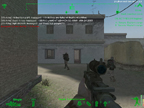
dead-in-iraq
Artist Joseph DeLappe presents documentation of a work-in-progress of online gaming intervention - dead-in-iraq. The project involves connecting to America's Army, the online first person shooter game/recruiting/PR tool of the US Army; DeLappe logs into the game using the screen name "dead-in-iraq" and, rather than have his character participate in the proscribed mission to seek and destroy opponents, DeLappe’s soldier functions as a passive participant. While his soldier is standing in place, DeLappe proceeds to type, using the game’s text messaging system, the name and date of death of all the soldiers who have died in Iraq, one line at a time. The text information appears on all team member’s screens interspersed with other messages from players and a running accounting of the progress of the game. “dead-in-iraq” is eventually killed by opposing players. A new game commences and the process continues. To date, over 300 names have been typed live into the gamespace. The project will continue until the end of the war. This work is intended as an online memorial and a protest.
Previous works in online intervention/gaming performance (Quake/Friends, Howl: Elite Force Voyager, ET tu Sir Alfred) may be viewed on DeLappe's website or by viewing his podcast now available on itunes.
Added on May 5, 2006
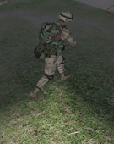
Deadly Games
All too often, public memorials honoring the victims of atrocities fall prey to bureaucratic processes in place to appease the living masses. Joseph DeLappe's newest project represents the work of one individual to honor the thousands of individuals who have now died in the Iraq war. This micro-memorial takes the form of an intervention in 'America's Army,' the online first-person-shooter video game used by the US Army to recruit new soldiers. DeLappe logs into the game with the user name 'dead-in-iraq' and proceeds to use the game's text messaging system to type the names, ages, and dates of death of recently deceased US soldiers in Iraq. Then he does nothing. He simply waits to be shot by other players, dies, and begins the process again, after being 'reincarnated.' Dead In Iraq is a thoughtful co-opting of the tools of digital culture to engage with the political issues raised in an era of high tech war. It is also one of a handful of recent online performances, staged in the diegesis of multiplayer games. The field of 'game art,' itself--of which this live performance is a unique extension--often meets criticism for its perceived lack of seriousness or its indulgence of nostalgia. But DeLappe's evocation of memory, in this game, is no laughing matter. He began the project in March of this year and has already input the names of 250 people killed in action since then. He plans to continue this action until the war ends. Until then, you can view screenshots of his participation in the game, and other users' responses to his messages, on the artist's website. - Marisa Olson, Rhizome News.
Dead in Iraq: It's No Game in Wired.
Posted by jo at 12:47 PM | Comments (0)
April 28, 2006
Cinedans

Workshop Interactive Dance Film @ Mediamatic
Workshop Interactive Dance Film - Cinedans 2006; June 25-29 @ Mediamatic; 1 July presentation of results.
THE WORKSHOP: Together with the Cinedans Festival, Mediamatic organizes a workshop on interactive dance film. In this workshop, 16 international dance filmers, editors and choreographers make interactive online dance films or dance film installations, using their own footage.
Interactive film offers interesting new forms of contact between the film and its viewer, but also requires other ways of shooting and editing the material. The participants research the relations between the paths of the camera, the movements of filmed bodies, the dramaturgy of the viewer and its movements on the screen or through space (in case of an installation), that together make up the form of the interactive dance film.
TRAJECTORY: The workshop is an intense 5-day process. Starting off with a close study of several intriguing interactive dance film projects on the first day, the participants create the content, form and interactive experience of their project, discuss it with experienced trainers and participants, and build a working prototype assisted by technical assistants.
Participants can bring up to 40 minutes of material, on dvd, or on FireWire harddisk, preferrably in Quicktime movie format. Participants use an easy-to-learn tool, that allows the projects to be published online, or on dvd-rom. All participants are assisted personally in realising their workshop projects. Specific technical knowledge of new media is not required.
HOW MUCH AND MORE INFO
The workshop fee is €300 (incl. VAT) for participants from new member states of the EU and €420 (incl. VAT) for participants from other EU member states.
Registration is possible online. Mail any questions you might have to workshops[at]mediamatic.nl or call Klaas Kuitenbrouwer: +31 20 6389901.
This workshop is made possible with the support of the MEDIA PLUS PROGRAMME of the European Community
Posted by jo at 12:18 PM | Comments (0)
Radio_Copernicus Archives at Media Library/ZKM Karlsruhe

Radio Station gets a new Home
Radio_Copernicus Archives at Media Library/ZKM Karlsruhe: Starting on April 28th 2006, the audio archives from Radio_Copernicus, the independent and mobile German-Polish Artists Radio Station will be accessible to the public as a permanent exhibit in ZKM/Center for Art and Media Karlsruhe. Nearly the entire program that ran on air for almost six months from July until December 2005 in Polish, German and English can now be selected and heard at the Media Library at ZKM Karlsruhe. Not only is it possible to research artists, program content, background information, time slots and dates on site, but also on the internet (under www.radio-c.zkm.de). The visitors of the ZKM can lean back comfortably in the listening-chairs (by Dieter Mankau for documenta 8)at the ZKM Media Library and listen to the numerous artist's talks, readings, soundscapes, interviews, live-sessions as well as the 27 commissioned works of the artists radio station.
Under the direction of Professor Sabine Breitsameter (Professor of Experimental Audiomedia/Berlin University of the Arts) with the support of the Polish project-coordinator, Robert Gawlowski (University of Wroclaw), and a team of approximately 50 people, a program was realized this past year that until now had been unheard of on any other radio station. Related to current development in media arts and electronic culture, Radio_Copernicus dedicates itself especially to radio art, electro-acoustic art forms, live performances, new literature as well as current cultural and societal debates and discourses.
The main focus of the program is the 27 commissioned works given explicitly to chosen artists such as Robert Piotrowicz, Zbigniew Karkowski, Guy van Belle, ElletroVoce, Duo Merzouga, the artists group LIGNA, Stefano Giannotti. About 200 media artists, people who work in radio, producers, technicians, and organizers collectively developed Radio_Copernicus into a broadcast station that implements an innovative cultural radio concept. This has happened not only through its program content from pop to 'high culture', including the entire range of sophisticated artistic radio work, but above all through its unconventional discourse and presentation forms.
Professor Sabine Breitsameter, "The positive and enthusiastic reactions from artists and listeners show how great the need is for an innovative, and at the same time, artistically sophisticated radio on both sides of the border. Because the audio archives of Radio_Copernicus will be open to the public regardless of the broadcasting time in ZKM, our project gains in having a long-term effect."
Radio_Copernicus, the independent German-Polish Artists Radio, ran from July 15th till December 31st 2005 on local and temporary FM frequencies as well as worldwide via Live-Stream in German, Polish and English 24 hours daily. The mobile station operated between the two neighboring countries. It moved from its first location in Stralsund (July/August 2005) to Warsaw (September 2005), then to Berlin (October 2005) and finally to Wroclaw (December 2005). Radio_Copernicus cooperated with the garage Festival in Stralsund, the Warsaw Autumn, the series of events, Dis_Positionen (Academy of the Arts Berlin) and Talking Back to Radio Radio as listener at the University of Wroclaw as well as at numerous local institutions.
Radio_Copernicus was based at Berlin University of the Arts (UdK) (Experimental Audiomedia/Sound Studies) and collaborated the Department of Journalism and Social Communications at Wrocław University/Poland. The project took place within the framework of Büro Kopernikus. The Büro Kopernikus is an initative of the Kulturstiftung des Bundes (Federal Cultural Foundation).
Head of programme and artistic director: Professor Sabine Breitsameter Project coordination in Poland: Robert Gawlowski Editorial Staff: Thomas Schumacher und Katrin Werner Production, editing and hosting: Martin Conrads, Thomas Doktor, Olaf Matthes, Jacek Skolimowski, Marta Sztanka, Sebastian Weiß, Adam Witkowski, Database and programming: Sebastian Weiß Sound Engineer: Domenico Utpadel
The publication of Radio_Copernicus is immediately available at book stores for 15 Euro. Radio_Copernicus. The German-Polish Artists Radio ISBN: 3-89462-138-9
Posted by jo at 11:44 AM | Comments (0)
Subtle Technologies 2006 Festival Toronto, Canada

RESPONSIVE ARCHITECTURES: REGISTRATION NOW OPEN
June 1-4, 2006: Subtle Technologies Symposium; May 30-June 1, 2006: CDRN Parametric Design Workshop. REGISTRATION NOW OPEN *Register by May 7, 2006 for discount*
How do responsive systems affect us? Interactive art, scientific research in complex systems and leading ideas in architecture and design come together in this 9th annual international forum. We invite artists, architects, designers, engineers, scientists, and the general public to join us in this dialogue. Research presentations and artist talks will be complemented by exhibitions and workshops.
Keynote lecture by Steven Vogel, author of the pioneering text 'Life in Moving Fluids.' The Symposium is preceded by the Canadian Design Research Network Parametric Design Workshop.
Subsidized registration is offered for students and the underemployed. Interested in volunteering? Contact us at ktrethewey[at]subtletechnologies.com
Partners: soundaXis, InterAccess Media Arts Centre, Canada Design Research Network, University of Toronto Faculty of Architecture, Landscape and Design, University of Waterloo School of Architecture
Supporters: Canada Council for the Arts, Canadian Heritage, Ontario Arts Council Toronto Arts Council, Bentley Systems Inc.
Angella Mackey
Project Manager
Subtle Technologies
Posted by jo at 11:39 AM | Comments (0)
Call for Submissions
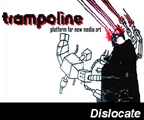
Dislocate: Trampoline in Tokyo
Dislocate Exhibition in Ginza and Koiwa, Tokyo; 28th July- 18th August 2006; curated by Emma Lewis in association with Trampoline and Ginza Art Laboratory. Call for Submissions. Deadline: 31st May.
We constantly swim through an invisible sea of hidden reality – our environment is not formed only by our physical surroundings but of its multiplicity of insubstantial networks – constantly transmitting and receiving. Physical geography is being transcended, psycho-geography is extended. We are never located in just one space. Here is not just here but also there.
‘Dislocate’ is an exhibition examining the tensions between the local and the global – the elements and identity of one local space which are simultaneously intersected by countless global links and influences.
In its indefatigable attempt to promote new media art to the world Trampoline – platform for new media art - is going to Tokyo this summer and is seeking submissions of works which engage with notions of multiple spaces and presence, the ubiquity of new media and the challenge to our sense of place.
We are particularly encouraging the submission of video work some of which will be shown on a showreel, others on single monitors. But we also welcome submissions for web streaming, computer based works and sound works. Work should engage with the theme of the exhibition on some level and proposals should outline how this connection is made.
In addition to this there is one project as part of the exhibition which the curator invites you to consider submitting to:
Audio Tour: In joining one space with another and exaggerating a sense of dislocation, the curator is keen to merge other cities with Tokyo in the form of an audio tour, touring one city within another. It is imagined that this audio tour would be worn by visitors to the exhibition and would instruct them on a small walking tour around the city, but as they are walking through the streets of Tokyo they will be listening to a tour of another city. The curator is keen to work with artists interested in audio guides and would like to develop a bilingual audio guide of another city which could then be presented in the area surrounding the gallery in Ginza, Tokyo, referencing one space within another.
If you have any ideas which you would like to develop further in relation to this project and in dialogue with Trampoline we would very much like to hear from you.
Deadline to submit proposals is May 31st. Please submit to:
Emma Lewis
Trampoline
Broadway Cinema
14-18 Broad Street
Nottingham
NG1 3AL
UK
emma[at]trampoline.org.uk
0115 8409272
Posted by jo at 08:08 AM | Comments (0)
April 27, 2006
Eyebeam Exhibition and Event
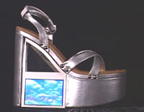
The Aphrodite Project: Platforms
The Aphrodite Project: Platforms is an integrated system of shoes and online services that combines the rich mythology of Aphrodite with the safety and advertising concerns of contemporary sex workers on the street. On view in Eyebeam's gallery May 2-13 will be a prototype of a silver-leather platform sandal with integrated LCD screen, speakers, internet connection and GPS tracking system. On May 13 visitors to the gallery will be able to track a model in real-time as she traverses the city wearing the platform prototype and join in a panel discussion between artists, technologists and sex work advocates. This event will conclude with a reading by Tracy Quan, performance by Ana Voog, Echo Transgression, and Melissa Gira, and live music by Natural Sphere. This event is open to the public free of charge with a suggested donation and will take place at Eyebeam, 540 W. 21st Street between 10th & 11th Aves.
Platforms--byNorene Leddy with Andrew Milmoe--is designed to question moral attitudes and value judgments, especially with this marginalized section of the population: Who gets new technology and when? What is the true value of sexual services? Using an archetypal model, is it possible to reclaim the profession for modern women? What are the ethics of surveillance and tracking? Is it possible to ensure that this information will empower and not endanger sex workers? Is it ever possible to guarantee that knowledge will stay within the hands of those who it is intended for?
The shoes address creativity and art making as well as practical issues of design and marketability. It is my hope that in addition to creating beautifully crafted objects; the project will contribute to the current international debate over the regulation, decriminalization, and legalization of prostitution.
Posted by jo at 01:34 PM | Comments (0)
Corposcópio
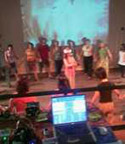
Circle dancing meets mobile technologies
Corposcopio is an experimental collaborative performance that associates circle dance and mobile technologies. The purpose of the interactive performance is to stimulate, simultaneously, the perception of the media in contemporary reality and the collective body emergence. Corposcopio departs from the experience of circle dance, a very ancient group activity, present in different cultures in the world, and aggregates real time image manipulation, software art, VJ, and remix aesthetics.
The transparent, ubiquitous and pervasive presence of computer systems in contemporary spaces is a quotidian fact. Nevertheless, the emergence of digital communities demonstrated the power of human factor in the disruptive use of technologies. Human beings are social beings. Our depart point is to bring an ancient practice, the circle dance, to the scenery of real time image manipulation, ubiquitous computing and mixed reality. The performance itself deals with co-creation development and uncertainty. Each performance has peculiar characteristics hence it is an open system, open to receive the group interaction and participation.
The circle is probably the oldest known dance formation. Ancient circle dances movements are cultural manifestations present in different countries around the world, including Greece, African, Eastern European, Irish Celtic, Catalan, South American, Central American and North American. They have a great power of community integration. The experience stimulates an extended consciousness, a simultaneously perception of the individual body and the collective body. Our hypothesis is that each group will catalyze the emergence of an embodied consciousness of our mediated situation in a different way. As Bernhard Wosien, one of the pioneer researchers on circle dance, has said, dance is a path to totality. In Wosien's view, circle dance has deep ritual characteristics and evokes a tremendous collective enthusiasm. In Corposcopio experience, we observed a great vibration produced by the group movement in harmony with the music. In Brazil, there is a lot of amazing circle dance and one of the most popular is called “ciranda”, whose movements are inspired by sea waves. Ciranda is performed by hundreds of people and some participants fall into trance.
The music has a fundamental role in Corposcopio project. The songs have been chosen by Andrea Leoncine and Andrea Soares, based on their research on folk music and Brazilian music. Dudu Tsuda has created new versions of traditional and folkloric songs, introducing unexpected accords and transformations on form. Tsuda's compositions are open systems that dialogue with enthusiasm and energy with the participants of the circle.
Corposcopio Project comprehends three different systems: the technological, the musical and the interactive arena, that is the place for the circle dance. The technological system is composed by systems of input and output. Two computers receive the images sent by mobile and unmovable devices. Wi-fi cameras, allocated in the dancers' bodies and cell phones transmit the images from the movable point of view. Three fixed cameras, situated around the circle and another one hanged on the ceiling provide the images from the unmoving angle. The camera situated on the ceiling transmits a design that reassembles different and dynamic mandalic patterns. The images received are manipulated in real time using Randox, software developed by Nacho Duran. The projection of images follows a script that has different levels and narrative elements.
Biography of the author
Lucia Leão is an interdisciplinary artist that has been leading researches in art and new technologies since 1989. She obtained her Bachelor of Arts degree in 1984, her MA and Ph D degrees in Communication and Semiotics: Information Technology from PUC - SP Catholic University in 1997 and 2001. Lucia Leão was Postdoctoral Fellow in Arts, in UNICAMP, Campinas, São Paulo, Brazil, from 2001 to 2005.
Leão's research is based on the hypothesis that the ancient studies of myths, labyrinths and rituals could help us to better understand and deeper interact with our contemporary mixed spaces. Her interest in the relationship between labyrinths and cyberspace led her to publish three books on this subject: "The labyrinth of hypermedia: architecture and navigation on cyberspace" (1999), “The labyrinth aesthetics” (2002), and “Interlab labyrinths of contemporary thought”(editor, 2002). She also published another books and collections. Her present research articulates the concept of nomadic wired bodies and ancient circle dances.
Lucia Leão is currently professor at PUC-SP and SENAC University, where she coordinates Cyberculture Research Group. Her articles and projects are available at www.lucialeao.pro.br
Corposcopio team
Lucia Leão
Artistic concept/direction
Nacho Duran
Software development and live image editing (VJ)
Rodrigo Gontijo
Live image editing (VJ)
Fernando Velázquez
System development and live image editing (VJ)
Andrea Leoncini
Choreographic project of circular sacred dances
Andrea Soares
Choreographic project of Brazilian circular dances
Dudu Tsuda
Musical creation
Gisele Fink
Percussion
Leonora Fink
Production
Posted by luis at 12:50 PM | Comments (0)
SURVEY: NEW MEDIA
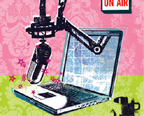
Among the Audience
"The era of mass media is giving way to one of personal and participatory media, says Andreas Kluth. That will profoundly change both the media industry and society as a whole.
As with the media revolution of 1448, the wider implications for society will become visible gradually over a period of decades. With participatory media, the boundaries between audiences and creators become blurred and often invisible. In the words of David Sifry, the founder of Technorati, a search engine for blogs, one-to-many “lectures” (ie, from media companies to their audiences) are transformed into “conversations” among “the people formerly known as the audience”. This changes the tone of public discussions. The mainstream media, says David Weinberger, a blogger, author and fellow at Harvard University's Berkman Centre, “don't get how subversive it is to take institutions and turn them into conversations”. That is because institutions are closed, assume a hierarchy and have trouble admitting fallibility, he says, whereas conversations are open-ended, assume equality and eagerly concede fallibility." From Among the audience, SURVEY: NEW MEDIA, The Economist print edition, Apr 20th 2006.
Posted by jo at 11:22 AM | Comments (0)
CTheory Live:
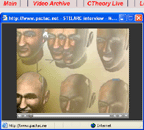
Stelarc in Conversation with Arthur & Marilouise Kroker
Dear CTheory Readers,
We are very pleased to invite you to the first installation of CTheory Live, a continuing series of conversations with leading artists and theorists from around the world. We begin with an interview with Stelarc, an Australian-based performance artist, whose artistic imagination is on the cutting-edge of new ways of understanding issues related to body, technology and the question of the interface. The interview was conducted between Australia and CTheory's office at the Pacific Centre for Technology and Culture at the University of Victoria, Canada.
The conversation with Stelarc can be found at:
http://www.pactac.net/pactacweb/web-content/video44.html
The next CTheory Live interview will be with Professor N. Katherine Hayles, Professor of Literature and Media, UCLA. The interview will focus on her three most recent books: _How We Became Posthuman_, _Writing Machines_, and _My Mother Was a Computer_.
kind regards,
Arthur and Marilouise Kroker
Editors, CTheory
Posted by jo at 11:21 AM | Comments (0)
Lecture Series
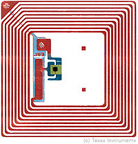
HOW I LEARNED TO LOVE RFID
How I Learned to Love RFID: Hartware MedienKunstVerein at the PHOENIX Halle, Dortmund Public lectures (in English), HMKV, Dortmund, in cooperation with RIXC, Riga Saturday, May 20, 2006, 10:00 - 18:00
The series of lectures brings together approaches and projects that artistically and critically deal with Radio Frequency Identification (RFID) Technology - a technology that is significantly being developed and advanced by companies and research institutes in Dortmund. This technology which at first glance seems to be a simple further development of the bar code (well known from the supermarket) is much more powerful that the good old bar code technology. RFID tags are passive radio transmitters, which upon receiving a minor wireless energy impulse are sending back the information stored on their memory. Today, this information can be read already at a distance of six meters - without the process getting noticed. In addition, with its unique identification numbering system, this technology will allow for a precise identification of every object worldwide. What will it be like to live in a world where all the objects constantly will be talking to each other?
PROGRAM
10:00 Begruessung und Einfuehrung / Welcome and Introduction Dr. Inke Arns (Hartware MedienKunstVerein, Dortmund) Rasa Smite (RIXC, Center for New Media Culture, Riga) Francis Hunger (Hartware MedienKunstVerein, Dortmund)
11.00 Keynote: Bruce Sterling (Autor, Belgrad / writer, Belgrade) Bruce Sterling is a science fiction writer who has, among others, shaped the notion of “cyberspace" together with William Gibson (“Neuromancer"). In his blog he discusses future technological developments.
12:00 Rena Tangens, padeluun (FoeBuD e.V., Bielefeld) Rena Tangens and padeluun are the most articulate and outspoken critics of RFID technology in Germany. They will speak about their Stop-RFID campaign, the Metro scandal, the use of RFID in the context of the World Cup and sketch a future vision for the use of RFID compatible with privacy issues.
13:30 Break
14:30 Rob van Kranenburg (Virtual Platform, Amsterdam) Rob van Kranenburg will speak about RFID and Pervasive Computing, i.e. how computer technology increasingly permeates our everyday life. He sees RFID as an unavoidable logistics technology that poses the question of social control.
15:30 Dipl.-Ing. Wolfgang Lammers (Fraunhofer Institut Materialfluss und Logistik, Dortmund) The Dortmund Fraunhofer Institute is one of the most significant research centers for RFID technology in Germany. An overview of its working areas and current research projects will be given.
16:30 Rasa Smite, Raitis Smits (RIXC, Center for New Media Culture, Riga) und Honor Harger, Adam Hyde (radioqualia, NZ/AUS/GB/NL) Rasa Smite and Raitis Smits will introduce RIXC, the Center for New Media Culture in Riga and its activities in the field of Locative Media. Honor Harger and Adam Hyde (radioqualia) will speak a.o. about Solar Radio Station, an installation developed in cooperation with RIXC.
18:00 Pause
19:00 - 21:00 Solar Radio Station - Live Installation (also on Sunday May 21, 2006) The Riga based group Clausthome and VJ Martins Ratniks (F5/RIXC) will perform live in the Solar Radio Station. The live audio stream from the VIRAC radio telescope in Irbene, carrying data from the sun and from space, will be electronically enhanced by Clausthome and interpreted visually by VJ Martins Ratniks.
The lectures take place as a part of the workshop “How I learned to love RFID" in the framework of the exhibition "mit allem rechnen/face the unexpected: Media art from Estonia, Latvia and Lithuania".
“How I learned to love RFID" is a cooperation between HMKV (Dortmund) and RIXC (Riga).
Venue: Hartware MedienKunstVerein at the PHOENIX Halle, Dortmund - Hochofenstr./ Rombergstr., Dortmund-Hoerde
Road description: http://www.hmkv.de/dyn/e_contact_roaddescription/
URL:
http://www.hmkv.de
http://www.rixc.lv
Supported by: Kulturbuero Stadt Dortmund, 38. internationale; kulturtage der stadt dortmund / scene: estland; lettland litauen in nrw, Kunststiftung NRW, Der Ministerpraesident des Landes; Nordrhein-Westfalen, Kultusministerium der Republik Lettland, Kultusministerium der Republik; Estland, Kultusministerium der Republik Litauen, 'Botschaft der Republik Litauen in der; Bundesrepublik Deutschland, Lietuvos Institutas, dortmund-project, LEG, PHOENIX, Coolibri (media partner).
Hartware MedienKunstVerein
Guentherstrasse 65 * D-44143 Dortmund
T ++49 (231) 823 106
F ++49 (231) 882 02 40
info@hmkv.de
http://www.hmkv.de
Posted by jo at 10:18 AM | Comments (0)
Social Video
![]()
Ten Video Sharing Services Compared
"The number of video-sharing sites has shot through the roof recently, as dozens of companies try to become the Flickr of the online video world. To this end, many video services have started offering new features like editing and remixability in an attempt to snatch a piece of the ever-expanding online video pie. But for the average user--who just wants to post a video on the 'net and share it with some friends--there are already too many options out there. All one really wants to know is, which site is going to work, with the least amount of hassle?
I took 10 of these sites [Eyespot, Google Video, Grouper, Jumpcut, Ourmedia, Revver, Videoegg, Vimeo, vSocial, YouTube] out for a test drive, and picked some winners. If you want to post, watch, share, or edit video online, this post's for you.
To test each service, I uploaded my demo reel (a 15MB Sorenson 3-encoded Quicktime file) to each site and compared video quality, site interface, community features, and functionality. Where applicable I also tried to embed the resulting video in a Wordpress page. Many of these sites are still in beta, and their functionality could change in the coming months, but if you're looking to post and share video today, this is the current state of things. [posted by Ryan Bilsborrow-Koo on DVguru]
Posted by jo at 08:00 AM | Comments (0)
(A)Bugs
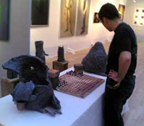
Ceramic Sculpture meets Bluetooth Hacking
(A)Bugs is an interactive ceramic sculpture --at a time when working with ceramics is regarded as "totally lame, not hype at all you know!"-- but also an ironic game on dogmas.
The piece uses the Bluetooth capabilities of visitors' mobile phones to adress them individually as they wander around the exhibition space by using or perusing their electronic identity, and getting their attention towards what has now become a common practice - invisible surveillance. Surveillance has been a major theme of the XLRMX.ORG collective (ChaosCam is an amusing proof of that) which will be present there. The sculpture actually "talks" to the viewer with speech synthesis, engaging him/her in subjects depending on what it can gather on the viewer and where s/he is located (reach, away, stays close, etc.)
Refusing to take side, the sculptural work is central to the critique of dogmas.
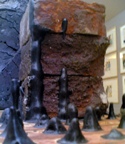
"Obscurantism is not only present in religion and politics with their fundamentalist or totalitarian surveillance dead-ends, it's also something that we have inside ourselves. Playing with these themes is important if one wishes to exercise one's criticism and not fall into the easy 'them vs us' kind of attitude. It's also about admitting we're human and that sometimes, we slip, we make mistakes. That's why a bug is here for. And we can do something about it." said Philippe Langlois commenting his work.
By Philippe Langlois and the XLRMX.ORG collective.
See it at the 51st Contemporary Art Biennale of Montrouge from Thursday, April 27 until Tuesday, May 16th, at the Montrouge theater.
[blogged by Regine on we-make-money-not-art]
Posted by jo at 07:51 AM | Comments (0)
April 26, 2006
Outrageous and Contagious
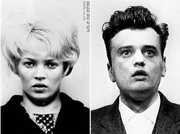
Bore Me, why don't ya
Running for just a week from next Monday 1 May 2006 at London's Institute of Contemporary Arts is, they claim, the World's first exhibition of viral emails. Outrageous and Contagious will showcase the cream of what appears in your inbox, split into various, sometimes topical, categories like New Orleans and Kate Moss. This image of the supermodel and sometime boyfriend Pete Doherty, doctored to look like reviled British murderers Ian Brady and Myra Hindley is one of the more controversial examples. The show will also set-up the second viral Oscars, called Germ, which take place later in the year. If you would like a taste of what's on offer, viral site Bore Me is one of the co-sponsors, and features a selection of movies and pictures that will be exhibited. [blogged by SummerSeventySix on Cool Hunting]
Posted by jo at 03:29 PM | Comments (0)
Deep Wounds

Healing and Reconciliation
Built between 1870 and 1878, Memorial Hall honors the Harvard graduates who died in the Civil War while fighting for the Union. Each of these men’s year of graduation, name, date of death and battle of death are permanently inscribed in the marble walls of the transept that serves as the main entrance to the hall. Deep Wounds uses this space to explore unfinished healing and reconciliation.
Entering the transept, we see the Union men's names, dates and battles on the walls; we see the beautiful stained glass windows and cathedral ceilings; and we see that the white marble floor has become luminous in certain central areas with hints of inscribed text. As we walk across these floor areas, the luminous skin blisters and opens to reveal descriptions of Harvard graduates who died while fighting for the Confederacy.

Each man's year of graduation, state, date of death and battle of death are projected onto the floor. Instead of a name, however, we see a relationship such as ‘father’ or ‘classmate’ that describes a family relationship each man had or a relationship he had to schoolmates on the wall. After the uncovering, the skin mends itself, covering the names once again.
The Confederate men are arranged on the floor facing or close to Union men from the same Harvard graduation year. The Union words are etched in red and the Confederate words are written in blue.
DEEP WOUNDS, a temporary site-specific art installation by Brian Knep (website | blog), was commissioned as part of a residency co-sponsored by Harvard’s Medical School (Department of Systems Biology) and Office for the Arts. It's on view through April 30, 2006: Monday – Thursday, 9 am to 7 pm; Friday, 9 am to 4 pm; Saturday, 2 to 5 pm; Sunday, 3 to 5 pm, Memorial Hall, 45 Quincy Street, Cambridge, MA.
Posted by jo at 02:59 PM | Comments (0)
Upgrade Lisbon #04
![]()
May meeting featuring André Gonçalves
Lisboa 20 Arte Contemporânea welcomes next Wednesday, May 3rd @19:30, The Upgrade! Lisbon monthly gathering featuring André Gonçalves who will present his project Resonant Objects.
Resonant Objects was awarded with the Portuguese 'Ernesto de Sousa Fellowship, for experimental intermedia art and was presented at Phill Niblock's Experimental Intermedia Foundation in New York in late March 2005. It started with the idea of creating micro-environments, computer controlled hermetic spaces where it is the artist's intention to explore several physical phenomenons related with the hearing, exploring them from the point of view of their sonority but also leaving space for an user or an observer to interact with the process. This particular project aims at bringing together sound and space through a physical phenomenon, where sound is used as a medium to excite space to be heard, sound generating more sound through space. The sound we get to hear is strictly related to the object's spatial characteristics, it's shape, dimensions and material but also it's relation with the site-specific architecture and again the spatial characteristics of the precise space that hosts all the objects.
André Gonçalves lives in Lisbon, Portugal. Since 2000 he has integrated and created several projects with diferent sound approaches namely 'ok.suitcase', 'etch', 'stapletape', 'ltthwhasp', 'iodo' and 'gigantiq'. Recently, Gonçalves also created audio-light installations like 'pRe-production', '8 steps', 'quiet not safe' and 'fake environment'. In 2004 he was granted with the 'Ernesto de Sousa Fellowship' for experimental intermedia art. Self-educated programmer, Gonçalves has been developing several audio-video applications in max-msp, flash, java and processing presented in multimedia showcases, online galleries or magazines, in performances and, most of all, in his day work for developing all his graphic, video and sound works. His discography includes releases on the labels Grain of Sound and Crónica Electrónica (pt), Stasisfield (usa), Efervescence (fr), Cherry Music (jp) and Antmanuv (can).
Upgrade! is an international, emerging network of autonomous nodes united by art and technology. Its decentralized, non-hierarchical structure ensures that each Upgrade! node (i) operates according to local interests and their available resources; and (ii) reflects current creative engagement with cutting edge technologies. While individual nodes present new media projects, engage in informal critique, and foster dialogue and collaboration between individual artists, Upgrade! International functions as an online, global network that gathers annually in different cities to meet one another, showcase local art, and work on the agenda for the following year. Upgrade! Lisbon is curated by Luís Silva
For more information or project submission, please go to http://www.lisboa20.pt/upgrade or http://www.theupgrade.net/
Posted by luis at 12:05 PM | Comments (0)
Sense of the City
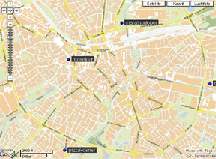
Observe Live Tracings
Launched last friday, Sense of the City involves ten civilians wandering in/around the Dutch city of Eindhoven with mobile phones and GPS; they're making traces with on-the-spot media and are being followed in real-time (in Dutch, best viewed with Firefox). The intention is to make their personal experience of the city visible. The project is by GeoTracing: contact Just van den Broecke at jus[at]justobjects.nl.
Posted by jo at 10:27 AM | Comments (0)
RIP Jane Jacobs
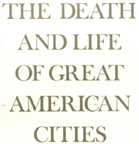
The Death and Life of a Great American Woman
Jane Jacobs, whose 1961 book, ''The Death and Life of Great American Cities," transformed the practice as well as theory of urban renewal in this country, helping to provide the rationale for Quincy Market and other urban restoration projects, died yesterday morning at Toronto Western Hospital, according to her publisher, Random House. She was 89.
Mrs. Jacobs had entered the hospital Saturday, after suffering an apparent stroke.
''She inspired a kind of quiet revolution," her longtime editor, Jacob Epstein, told the Associated Press. ''Every time you see people rise up and oppose a developer, you think of Jane Jacobs."
Mrs. Jacobs' vision of the livable city, with its emphasis on diversity, activity, and human scale, soon became commonplace. Yet at the time ''Death and Life" was published, it seemed both radical and anachronistic.
Where Mrs. Jacobs celebrated sidewalks and pedestrians, city planners in the first two decades after World War II focused on high-rises and expressways. Her love of varied urban textures and human density was anathema to a renewal process dedicated to tearing down old neighborhoods and replacing them with tower blocks uniformly sprouting out of depopulated greenery..." Jane Jacobs, 89; author's vision inspired 'livable city' movement by Mark Feeney, Boston Globe, April 26, 2006.
Posted by jo at 10:05 AM | Comments (0)
polymorphic [d(eoxyribo)n(ucleic) a(cid)]:
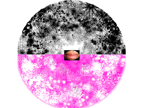
DNA in Love
polymorphic [d(eoxyribo)n(ucleic) a(cid)]: a love story--by Marta Lwin--is an installation of a DNA driven conversation between two people in love. Featuring actual personal DNA sequences mapped to generative language revealing the inner secrets of genetic compatibility. It is on exhibit at the ITP Spring Show 2006, Tuesday, May 9 from 5 to 9pm and to Wednesday, May 10 from 6 to 9pm.
The DNA sequenced are derived from an collaboration between Lwin and scientists at NYU Medical Center, Study of Human Genomics, and the American Museum of Natural History, Center for Comparative Genomics. The are visualized by using two video monitors (with audio), and computers running custom software written in Java. A synergistic interaction exists between the DNA sequence and the custom software to trigger video. The video depicts lips speaking the DNA sequence a mapped to the Roman alphabet. The disembodied lips take turns speaking the code to one another, at times interrupting at other times remaining silent.
The DNA, while invisible is encased in visible plates which are laser etched with contemporary scientific iconography, creating a decorative surface polymorphic [d(eoxyribo)n(ucleic) a(cid)]: a love story looks at the contemporary methodology for encoding DNA, and it's application and ethical ambiguities. The web based documented process of creating the installation comprises the theoretical investigation of turning material DNA into binary information, with special attention to lab process.
Lwin is looking at the current scientific lab practice of extracting DNA, and treatment of human materiality as it moves into binary representation. With special attention to Norbert Wiener's cybernetic theory, Lily Kay's analysis of the inherent informatic bias in DNA science, and theoretical writings by Marx, Deleuze + Guattari, and contemporary thinkers such as Thacker, Massumi, and Agamben.
Posted by jo at 09:52 AM | Comments (0)
Anticipating the Past: Artists : Archive : Film
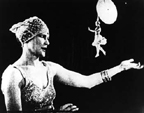
Symposium Exploring Use of Archival and ‘Found’ Film and Video
Friday 12 May 2006, 18.30 - 20.00, Saturday 13 May 2006, 10.00 - 18.30; Starr Auditorium, Tate Modern, Bankside, London SE1 9TG; Book tickets online or call 020 7887 8888.
The experience of viewing projected archival or ‘found’ film and video can have a seductive, even spellbinding effect on the viewer. The moving image’s material and aesthetic qualities can act as a trigger to memories true or false, sharply evoke a sense of time and nostalgia, or conjure fantasies of history.
This international symposium draws together a collection of voices and perspectives to examine the work of artists and filmmakers who have purposefully manipulated these materials. In doing so, these practitioners have explored the archive and its inherent qualities, dislocated archival material from its original purpose and intention, and thereby revealed new readings, meanings and questions.
George Barber, Neil Cummings & Marysia Lewandowska, Alex Farquharson, Yervant Gianikian & Angela Ricci Lucchi, Patrick Keiller, Elizabeth McAlpine, Mark Nash, Marcel Odenbach, Pat O’Neill, A L Rees, Heather Stewart, Benjamin Weil and Akram Zaatari.
On Friday 12 May, A L Rees introduces the imaginative re-cutting of found footage by film artists since the 1920s. Using short works and extracts, this talk reviews some of the ways in which 'films beget films' (Jay Leyda) in the
avant-garde.
On Saturday 13 May, further ideas on the uses of found footage and archival material will be explored in three different sessions:
Interrogating Archives asks what are archives other than passive repositories that catalogue the past following their own arcane criteria, and freeze it for posterity. Artists and curators will discuss their approaches to the ‘archive’, both as a concept and as an institution. In History and Politics discussion will focus on artists who interrogate newsreel and documentary images to reclaim some sense of humanity, or to pursue more fundamental truths, or to invent some missing pieces of a puzzle. Three generations of practitioners, interested in the humorous and disturbing subtexts beneath the polished surface of popular cinema, discuss their different methods and objectives towards moving-image collage in Remaking Hollywood. Screenings of individual work by Martin Arnold, Joseph Cornell and Malcolm Le Grice accompany extracts of work by the participants.
Posted by jo at 09:38 AM | Comments (0)
The Kitchen's Eighth Annual Sidney Kahn Summer Institute

Come Together
The Kitchen's Eighth Annual Sidney Kahn Summer Institute presents Come Together, Artistic Director Harrell Fletcher, July 17 - August 4, 2006. Come Together is a three-week, intensive program, fully accredited by Sarah Lawrence College (3 credits), focusing on expanded ideas of art-making and creativity in relation to collaboration, community involvement, and activism. Throughout the program, artists will explore a wide range of socially-responsive and community-based art practices as they go out into The Kitchen’s Chelsea neighborhood to research and develop site-related projects.
APPLICATION DEADLINE MAY 8, 2006 TUITION $2,600 (includes meal plan). A limited number of partial scholarships is available. Financial aid applicants are strongly urged to apply early. For application and complete program information, contact the Summer Institute Coordinator at rachael[at]thekitchen.org or (212) 255 5793 ext. 14. Click here to view the application.
Posted by jo at 07:52 AM | Comments (0)
April 25, 2006
European Media Artists in Residence Exchange 06
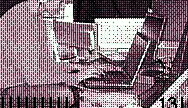
Call for entries
EMARE - Grants for European Media Artists for UK, Germany and The Netherlands. The twelfth European Media Artists in Residence Exchange will take place in Summer 2006 to Spring 2007.
Europe based Media Artists working in the fields of digital media including internet and computer based art, filmmakers, sound and video artists are invited to apply for a two month residency at VIVID, Birmingham, England (www.vivid.org.uk); at IMPAKT, Utrecht, The Netherlands (www.impakt.nl) or at Werkleitz Gesellschaft in Halle, Germany (www.werkleitz.de/emare). Students are not permitted, but young artists encouraged. EMARE includes a grant of 2.000 Euro, 250 Euro travel expenses, free accomodation, access to the technical facilities and media labs and a professional presentation. Entries should include a CV, (audio)visual reference projects documentation (no originals) and a proposal sketch for the project which should be developed within EMARE.
http://www.werkleitz.de/projekte/emare/index_e.html
Deadline: May, 15th, 2006 (post stamp)
Application form: http://www.werkleitz.de/emare
Please send your application to:
Werkleitz Gesellschaft e.V.
EMARE
Schleifweg 6
D-06114 Halle (Saale)
Germany
fon: +49 345 68246-0
fax +49 345 68246-29
emare@werkleitz.de
www.werkleitz.de/emare
EMARE is supported by the Ministry of cultural affairs Saxony-Anhalt; Arts Council of England, City of Utrecht, British Council and the Goethe Institute.
Posted by luis at 09:29 PM | Comments (0)
BreadboardBand

Electronic Improvisational Music Performance with DIY wiring
The Breadboard Band is a performing band that uses breadboards made of freely constructed electronic circuits to play music. We produce audio and visual expression through the most minimal, fundamental elements in the form of showing the electronic components of an instrument while directly touching and forming the electronic circuit by hand. The electric signals released from hand-made electronic circuits releases extremely rough and ferocious wave patterns. This performance is based on improvisational interplay, and we pull powerful music into shape through each member's operation, while discovering new sounds by hand.
Keywords: Breadboard, Improvisation, Electronic Musical Instruments, On-the-fly Wiring, Bending, Techno-Noise, iPod, Discrete, Musical Performance, Programmable Device

The Breadboard Band is one that uses a breadboard to perform music. A breadboard is a board that is perforated with connector holes into a grid-shape, to which electronic components are inserted in order to build a prototype of an electronic circuit. The electronic components can be inserted or removed with ease, making it simple to change the wiring with jumper cables. Utilizing the features of the breadboard, The Breadboard Band creates audio and visual circuits on the board, and modifies them during performance.
Today, 100 years from the public performance in 1906 of the Telharmonium, the first electronic musical instrument, The Breadboard Band raises objections toward black-box electronic musical instruments and computers. This objection is raised in the form of showing the electronic components of an instrument, directly touching and forming the electric circuit by hand, and producing audio and visual expression through the most minimal, fundamental elements. This can be considered the hardware version of software programming. The circuit change during a performance is called "On-the-fly Wiring".
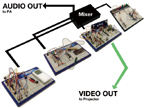
The performance of the circuits on the breadboard is less than 0.1% of that of electronic audio and video devices offered commercially. The electric signals released from hand-made electronic circuits releases extremely rough and ferocious wave patterns that might destroy a commercial instrument. However, the primal screams of ecstasy released from the electric circuits surge from the depths of modern society that is surrounded by sophisticated information technology, and stirs us with emotion.
The Breadboard Band's performances based on improvisational interplay, and we pull powerful music into shape through each member's operation, while discovering new sounds by hand. Various elements blend together, becoming one from beats made through analog oscillation circuits, riffs made through programmable chips, noises made through magnetic head, scratches made through a hacked iPod, and the videos of changing audio signals. It may be quite humorous to see the serious expressions of the performers as they grapple with small electronic components, but they match any band in vigor and potency.
Posted by jo at 01:48 PM | Comments (0)
Hypertext 3.0:
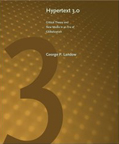
Critical Theory and New Media in an Era of Globalization
"George Landow's widely acclaimed Hypertext was the first book to bring together the worlds of literary theory and computer technology. Landow was one of the first scholars to explore the implications of giving readers instant, easy access to a virtual library of sources as well as unprecedented control of what and how they read. In hypermedia, Landow saw a strikingly literal embodiment of many major points of contemporary literary theory, particularly Derrida's idea of "de-centering" and Barthes's conception of the "readerly" versus "writerly" text.
From Intermedia to Microcosm, Storyspace, and the World Wide Web, Landow offers specific information about the kinds of hypertext, different modes of linking, attitudes toward technology, and the proliferation of pornography and gambling on the Internet. For the third edition he includes new material on developing Internet-related technologies, considering in particular their increasingly global reach and the social and political implications of this trend as viewed from a postcolonial perspective. He also discusses blogs, interactive film, and the relation of hypermedia to games. Thoroughly expanded and updated, this pioneering work continues to be the "ur-text" of hypertext studies." Hypertext 3.0: Critical Theory and New Media in an Era of Globalization (Parallax: Re-visions of Culture and Society) by George P. Landow. [Thanks Jeremy]
Posted by jo at 11:29 AM | Comments (0)
Helena Producciones'
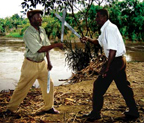
6 Cali Colombia Performance Festival
The 6 Cali Colombia Performance Festival--25 – 29 April 2006--is a project of the independent artists collective Helena Producciones (Wilson Díaz, Ana Maria Millán, Claudia Patricia Sarria, Andrés Sandoval y Juan David Medina). This project is held in Cali-Colombia since 1998.
The Cali Performance Festival celebrates and encourages excellence, risk, creativity, participation and debate through partnership, knowledge, quality, access and education. The Festival promotes symbolic and material communication between the Colombian community, Colombian and international artists, curators, art administrators and artistic networks, generating cultural strategies around art which may have an impact upon our community.
The VI Festival will include 3 exhibition, 3 workshops, public interventions and a performance journey. These activities, free for the general comunity, will take place in several public, private and independent spaces around the city.
The Festival will be held in Cali, a Colombian city with a very critical situation due to its current run down economy and the proximity of the Colombian Presidential elections which will take place on the 28th of May.
Cali is a tropical city located in the middle of sugar cane fields and refineries related to the influence of the Spanish Colony after the seventeenth century. This postcolonial situation gives the regional culture a special and interesting character.
The VI Performance Festival will be an exciting event for artists, activists, curators, theorists, art administrators, professional networks and the general public, as the local and national context brings together historic, political, geographic, economic and environmental issues that will provide a very interesting scenery for discussion and debate.
Guests:
Alessio Antoniolli, Fernando Arias, Tania Bruguera, Colectivo Cambalache, Teodora Diamantopoulos, Escuela de Esgrima con Machete de Puerto Tejada, Federico Guzmán, GRATIS, Las Malas Amistades, Les Gens d´ Uterpan (Franck Apertet y Annie Vigier), Live Art Development Agency, Caitlin Newton-Broad, Maria Inés Rodríguez, Armando Silva, Silverio y Miki, Virginia Torrente, Vincent + Feria
Selected Artists:
Wilfrand Anacona, Natalia Cajiao, Colectivo Estrato Cero, Colectivo Pornomiseria, Des-carrilados, Juan Carlos Dávila, Etienne Demange, El Vicio, Yury Hernando Forero, Carlos Franklin y Claudia Gómez, Boris Marlon Galvis, Pedro Gómez Egaña, Karime García, Beatriz López y Maria Isabel Rueda, Los Impedidos, Mucho Maché,Guillermo Marín, Luis Mondragón, Fabio Melesio Palacios, Agustín Parra, Juan Sebastián Peláez, Alfonso Pérez, Fernando Pertuz, Pope Noveau, Edinson Javier Quiñónez, Carmen Helena Rodríguez, Oskar Romo, Sangre de Palomo, Malcom Smith, Jorge Suzarte y Leandra Plaza, The Rimembers, Fernando Uhia, Rened Darío Varona, Gustavo Villa, Lorena Zúñiga y Martha Posso
Funders and Sponsors:
Prince Claus Fund, Secretaría de Cultura y Turismo de Cali, Feriva, Triangle Art Trust, Centro Cultural Comfandi, ParqueSoft, Embajada de España (Programa Miradas), Cámara de Comercio de Cali, British Council, Gobernación del Valle, Fondo Mixto, Centre dArt Contemporary Bretigny, adami, Casa de América, Triangle France, Doméstico, Lugar a Dudas, Hotel La Luna, Alianza Francesa de Cali.
Posted by jo at 10:02 AM | Comments (0)
Seeing Sound
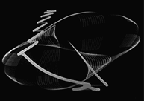
Abstronics: Mary Ellen Bute
Mary Ellen Bute has cropped up at Dataisnature before whilst talking about methods for visually representing sound - but in that instant, only a mention. Although hardly know today, her pioneering, highly experimental films were watched by millions at the time, as they were played as ‘shorts’ preceding the main features film in theatres showing across the States.
After studying Lighting, she mixed with the likes of Leo Theremin and Thomas Wilfred, whose Colour Organ, the Clavilux, definitely left an impression on her.
Later on, impressed by the mathematical musical systems of Joseph Schillinger, which she incorporated into her methodologies, she began to make abstract-geometric animations that represented music. Undoubtedly she was influenced by the great musical animations of Oskar Fischinger. From 1939 she began to work in colour, employing the used of oscilloscopes; using this technique she made two fairly well know films, Abstronic and Mood Contrasts.
Although very hard to track down, sound responsive computational artists would surely understand, enjoy, and perhaps learn from the work of Bute, as well as the more widely know Fischinger, of course. [blogged by Paul on Dataisnature] [Related: Shape of Song]
Posted by jo at 09:18 AM | Comments (0)
Pierre Proske'S

Voiceprints
An Australian digital artist is using his voice to design textiles. Pierre Proske has developed computer software that translates different frequencies in someone’s voice into spiral patterns, producing what he calls ‘voiceprints’. Proske developed the software while doing his masters in art and technology at Sweden’s IT University of Göteborg.
He’s used the software to design a pattern inspired by elements of Japanese textiles, a design that appeals to him because of its simple repeated elements. "Computer code is very simple and minimalistic, you have these ones and zeros, so I thought it would be good to choose a very minimalistic textile as well."
The textile is made up of repeated spirals of more or less the same size in a particular dense and fairly regular arrangement. Proske then scanned one of the spirals into his computer as the basic element in his voiceprint design. Next he used the software to analyse the frequency profile of a short sample of a voice. "You might get a bunch of low frequencies and some high frequencies depending on what you say and how you say it," he says.
The software translates the relative amounts of different frequencies of a particular sound into a particular layout of spirals of different sizes. Different voice sounds can create different layouts of the spirals, says Proske. He says the software could be used to generate patterns for textile and graphic design. "The idea is that it is actually meant to be quite accessible. Anybody could use their voice to generate these patterns."
Proske sees his research as a modern take on old technologies. "I’m kind of inspired by the connection of textiles and computers because they have a historical link that goes back to the automation of the loom in the 1800s," he says. Proske says the same punched cardboard cards used to code for textile patterns were later used to program the first computers. [blogged by Regine on TWENTY1F]
Posted by jo at 09:11 AM | Comments (0)
Joi Ito
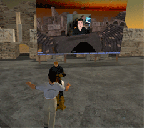
Recursive video in Second Life
Had our first meeting inside of Second Life today to talk about the island. Thanks to everyone who showed up. Special thanks to Aimee Weber who donated an amphitheater! She showed me how to play videos inside of Second Life. So... I tried making a very recursive video of me watching a video of me watching a test video of myself. Watching a video together inside of Second Life actually works well. The audio and video quality is excellent and you can chat about the video and other things while you watch. It's really neat sharing a space like this together...
I uploaded a video iPod format m4v and a AVI format of the movie. Too bad the audio doesn't work... or for your sake, maybe it's better that it didn't. [via Joi's blog]
Related: 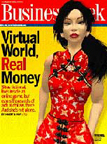
Virtual Lives
"...Business Week (via Terranova) has a podcast, two slideshows and a story about Second Life and other MMORLG, money and advertising. Good wrap-up if you're interested in the topic but don't have the time to follow it closely (check also The Future of Credit Cards - Earning virtual currency for spending in the real world & other world bridging, by Phillip Torrone.)
Anshe Chung - the "virtual Trump" - even gets the cover of the mag. The land development business, which the avatar has built from nothing two years ago, has turned into an operation of 17 people. Second Life participants pay Linden dollars, the game's currency, to rent or buy virtual homesteads from Chung so they have a place to build and show off their creations. They can then convert the play money into dollars by using their credit card at online currency exchanges. To handle rampant growth, Chung opened a 10-person studio and office in Wuhan, China. Says Chung's owner: "This virtual role-playing economy is so strong that it now has to import skill and services from the real-world economy."..." [from Regine's post on we-make-money-not-art]
Posted by jo at 09:06 AM | Comments (0)
Nowhere
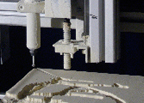
Rhizomatic Sculpture
To be born, grow up and die. All in three weeks. This is the vital cycle of Nowhere, electronic landscape conceived by Ralf Baecker. It's a net project, based on a search engine results (a concept originally developed here and later experimented also in Emailerosion). In Nowhere the user does his searches on the German Metager. For every accomplished search a mechanical arm is activated, eroding a block 75x75x10 cm made out of PU Foam, that can be seen in a window on the website. Depending on the time spent to index the data, the arm's eroding movement will be slower or faster. Rivers, canyons, valleys... the created topography exists only for the research time period.
The simultaneity of the different connections and the alternation of day and night (that usually corresponds to a major or minor net access) influences the transformation rate. The opportunity to noticeably modify a sculpture that's visible online only enhances the relationship between the contemporary artistic expressions evolutions and the virtual reality potential. In this case the space / object is transformed in a space / image. The interaction and man / work reaction can be tuned and manipulated without physical, temporal or representative limits. The work assumes a rhizomatic character, that is to say a network of polymorphic entities with different access points. This is the result of an interaction amongst heterogeneous elements, developing an internal non-hierarchical communication, or in other words the path mapped out with the connected users' cognitive links. Francesca Tomassini, NEURAL
Posted by jo at 08:56 AM | Comments (0)
Blind Ditch
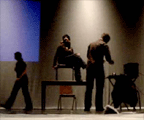
WHO WANTS TO BE A HERO NOW?
Blind Ditch invite you to state your opinions and ask some questions in our performance installation WHO WANTS TO BE A HERO NOW? showing as part of the Exeter Text Festival, UK, April 24th-14th May 2006.
Send us a mobile phone short or digital camera mpeg to +44 (0)7890 801203 or contact[at]blindditch.org and it will be downloaded onto our website. Your work will be continually screening online from April 24th and shown in the Exeter Phoenix Gallery as part of the tEXt Festival. Tell us what action should we make to change the world for the better. Please pass this on to anyone across the world you would like to participate, translate and disseminate. Respond in your mother tongue or English Please note that the word hero is being used to speak about both men and women.
Please be aware that by participating in this project you are agreeing for Blind Ditch to use your image and words in our work. Your statements will be curated with live performance work and available online and in the gallery throughout the duration of this project.
Posted by jo at 08:43 AM | Comments (0)
Quoth

NetJamming with Ominiscient Interpreter
Quoth is a dynamic interactive fiction system, in which authoring is done from a player's perspective, from within the running work. Quoth draws upon the concepts of pervasive anthropomorphisation, executable natural language, and revisionist narrative. The major use of Quoth so far has been for musical livecoding.
In traditional interactive fiction, the player speaks to an ominiscient interpreter. There may be dialogue with "non-player characters", but it is mediated by the interpreter. In Quoth the player is always speaking directly to some item in the universe. The traditional omniscient interpreter is represented by the universe itself. This allows for each item in the universe to have a different vocabulary, or even a different "interpreter" altogether. It also provides the player with more fluid interaction with each item...
Posted by jo at 08:14 AM | Comments (0)
Sharing Is Daring:
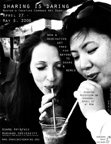
CC Art show in Boston opens on April 27
Elizabeth Stark of Harvard Free Culture reports that Sharing Is Daring -- a terrific art show featuring works offered under Creative Commons licenses -- is ready to rock with an opening reception on April 27. Sharing is Daring showcases new & derivative artworks released under flexible licenses that allow for sharing & remixing. The exhibition will feature a range of graphic, photography, video, and multimedia works by:
~ Abram Stern ~ Matt Vance ~ Elton Lovelace ~ Brian Zbriger ~ Suburban Kids with Biblical Names ~ Shanying Cui ~ Ben Sisto ~ Tim Jacques ~ Rebecca Rojer ~ Greg Perkins ~ Ryan Sciaino ~ David Meme ~ Matt Boch & Claire Chanel ~ selections from the 100 Second Film Festival ~ [posted by Marisa on Rhizome]
Please join us for our opening event on Thurs., Apr. 27, 2006 at 8pm at the Adams ArtSpace, Harvard University, Plympton at Bow St., in Cambridge, MA. Food and drink will be served.
Posted by jo at 08:11 AM | Comments (0)
WanderingScribe

Park and Write
"Tried to recite poetry to induce sleep — often helps. Head like a seive though, all this wandering the country in the last year under such extreme conditions seems to have emptied my head of past knowledge. As if survival demands a new skill set, and the brain clearing space for new information. What you used to know no longer necessary, the past overwritten. Although can't quite believe that of poetry, poetry is always necessary. Recalled fragments in the end, but whole poems I used to know well eluded me. And that saddened me as much as anything else has recently. Tried really hard to take the focus off my freezing nose and growing stiffness and despondency and remember Yeat's 'Song of Wandering Angus', which is my favourite Yeat's poem — seemed apt too, given title of my blog, and living here in a car in the woods, and the content of the poem." From WanderingScribe; also see Park and Write, BBC News.
Posted by jo at 08:00 AM | Comments (0)
April 24, 2006
Cobi van Tonder
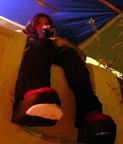
Skateboard music interface
Cobi van Tonder, author of the brilliant Ephemeral Gumboots, has been commissioned a new work for ISEA2006. The project, Skatesonic, uses the motions and sounds of skateboards and explores their inherent ambient rhythm to create music. In a way, each move translates to musical parameters and the rider ends up skating through a landscape of music (which s/he influences over time).
Skatesonic will work in both solo and group situation. The system "listens" to space through movement, which it maps out and translates into music. Each of the four boards will map to a unique sound and structural parameters, so if there are 4 riders they will be able to jam like a band. For example, Skatesonic will allow skaters to buffer through a sound file in Max, meaning that as they rolls over a certain distance it is as if they have a record needle under the board, and every inch of movement progresses the sound. The live microphone input also reveals information about the texture of surface under the board and intensity of movement. From an interview with the artist by Sylvie Parent. [blogged by Regine on we-make-money-not-art] Related project: Musique Concrete by Simon Morris.
Posted by jo at 05:29 PM | Comments (0)
ISEA2006

Symposium Papers Online Forum
ISEA2006 Symposium Papers Online Forum, April 24th to May 29th: ISEA2006 is taking place in San Jose, California, August 7-13. More information about the Symposium and related ZeroOne San Jose Festival.
Beginning Monday, April 24th, ISEA2006 will host a month long series of discussions on the accepted paper abstracts for each of the Symposium Themes: Interactive City, Community Domain, Pacific Rim and Transvergence.
An important objective to ISEA2006 is enabling conversation and discourse between audience(s) and presenters. Toward that objective this years ISEA incorporates a single main track of presentations + artists presentations combined with a pre-publishing model. The reading of papers is not permitted. Instead authors will present their abstracts in the on-line Forum and then pre-publish full manuscripts weeks prior to the Symposium. The goal is to inform and influence both authors and audiences as well as create conversational relationships and provide for advanced consideration of topics to be presented at the Symposium.
At ISEA2006 each theme will have two extended conversational sessions in which several authors present summaries of their papers followed by a moderated conversation and audience interaction.
An important role in the Symposium and Forum is that of the Moderator. We have invited a group of prestigious Moderators who will facilitation of individual sessions of the Online Forum and Symposium.
Interactive City: Anthony Burke
Community Domain: Sara Diamond
Transvergence: TBA
Community Domain: Alice Ming Wai Jim
Transvergence: Wendy Chun
Pacific Rim: Amanda McDonald Crowley
The ISEA2006 Papers Forum, April 24nd to May 22nd begins with Interactive City. Beginning with Interactive City, abstracts for each of the Symposium themes will be presented in a series of open public discussions.
Interactive City paper titles and authors:
Mirjam Struppek, Urban Screens
Tapio Mäkelä, Ars Memorativa in the Interactive City
Alison Sant, Redefining the Basemap: From Scenography to Planetary Network for Shanghai 2010
Each week introduces a new theme and abstracts for consideration.
Forum Schedule and Moderators:
Transvergence 1: May 1-May 7
Moderator: TBA
Gheorghe Dan and Alisa Andrasek: Phylotic BodayScapes / Entheogenic Gardens Poly-Scalar Heterotopic Botany
Oron Catts and Ionat Zurr, Towards a New Class of Being-The Extended
Body
Josephine Bosma, Voice and Code: From spoken word and song to writing music to code
Community Domain 1: May 8-14
Moderator: Sara Diamond
Trebor Scholz, The Participatory Challenge: Incentives for Online Collaboration
Valentina Nisa, Mads Haahr and Ian Oakley, Community Networked Tales: Stories and Place of a Dublin Neighborhood: The Media Portrait of Liberties
Kevin Hamilton, Absence in Common: An Operator for the inoperative Community
Community Domain 2: May 8-14
Moderator: Alice Ming Wai Jim
Joline Blais, Indigenous Domain: Beyond the Commons and Other Colonial Paradigms
Sharon Daniel, Public Secrets: Information and Social Knowledge
Mara Traumane, Media Referentiality: Productive Knowledge Networks in Experimental Arts
Transvergence 2: May 15-21
Moderator: Wendy Chun
Steve Anderson, Coming to Terms with the Digital Avant Garde
Jon Ippolito and Joline Blais, Art as Antibody: A redefinition of art for the Internet Age
Ned Rossiter, Organized Networks as New Institutional Forms
Pacific Rim : May 22-29
Moderator: Amanda McDonald Crowley
Timothy Murray, Chinese Archival Futures
*additional Pacific Rim participants to be announced.
Please join us for a lively and informative discussion.
For more information on Paper Authors and the Symposium: http://
01sj.org/content/blogcategory/135/144/.
Joel Slayton, Chair ISEA2006/ZeroOne San Jose
Steve Dietz, Director ISEA2006/ZeroOne San Jose
ISEA2006 Symposium
The 2006 edition of the internationally renowned ISEA Symposium will be held August 7-13, 2006, in San Jose, California in conjunction with the inauguration of ZeroOne San Jose: A Global Festival of Art on the Edge, a milestone festival to be held biennially.
The 13th International Symposium on Electronic Art (ISEA2006) focuses on the critical, theoretical and pragmatic exploration of four important themes:
Transvergence, Interactive City, Community Domain and Pacific Rim
What tactics, issues and conceptual practices expose or inform the distinctions of these subject terrains relating to contemporary art practice? What analyses illuminate art practice engaged with new technical and conceptual forms, functions and disciplines; provide for innovative tactical implementations of cultural production involving urbanity, mobility, community and locality; examine the roles and responsibilities of corporations, civic and cultural organizations, discuss strategic and economic planning as it relates to creative community; serve to expose new portals of production and experience; provide for interpretive bridges between cultures and identities; and provide for provocative examination of contemporary political and economic conditions? How is new media art practice re-shaping the world?
The ISEA2006 Symposium is an international platform for artists, cultural producers, media theorists, curators and the general public to share the latest ideas and practices involving new media. Enabling discourse across disciplines, ideologies and philosophical frameworks is an important objective as is the facilitation of discussion and conversation. Audience participation is facilitated through expanded moderated sessions, an afternoon Poster Session/Reception and through an on-line forum featuring the pre-published abstracts and papers.
Posted by jo at 03:34 PM | Comments (0)
SAVE THE INTERNET

SPEAK OUT NOW
Congress is now pushing a law that would end the free and open Internet as we know it. Internet providers like AT&T and Verizon are lobbying Congress hard to gut Network Neutrality, the Internet's First Amendment. Net Neutrality prevents AT&T from choosing which websites open most easily for you based on which site pays AT&T more. So Amazon doesn't have to outbid Barnes & Noble for the right to work more properly on your computer.
Many members of Congress take campaign contributions from these companies, and they don't think the public are paying attention to this issue. Let's show them we care - please sign this petition today.
Posted by jo at 02:50 PM | Comments (0)
Workshop: Social Park:
![]()
Collaborative Networks in Public Spaces + The Politics of Play
Social Park: Collaborative Networks in Public Spaces + The Politics of Play Amy Franceschini (Futurefarmers) & Myriel Milicevic Curator : Isabelle Arvers Thursday, 27th april 2006 2-6pm – Mains d’œuvres – Mal au Pixel - Paris
Play can offer a common ground for people to meet and exchange. Almost everyone likes to play a game. The term "playing around" infers a sense of impermanence that can allow for letting down ones guard. Within this realm of play, games can provide a relational platform to play-out interpersonal frustrations, role-playing and risk taking. Often times this provides a sense of freedom that cannot be found in a sanctioned panel discussion, meeting or the classroom.
Social Park will be a collaborative workshop inviting artists, sociologists, designers, game designers, urban planners to come together in an expedition. The purpose of this journey will be to foster collaborative networks in the city through the medium of play. The workshop will take the form of an exchange and collective learning experience. The workshop will be divided into 3 parts; research, experimentation and implementation.
The first part of the workshop will involve exchange and playing games. Workshoppers will be asked to bring in games and examples of art projects/situations that foster collaboration. The games will be played and deconstructed in terms of rules and game play. One of the most exciting part of playing a game is breaking the rules or customizing the game. The second part of this workshop will involve observation, documentation and classification of the existing modes of collaboration in a city. The third part will involve the development of a game to play that fosters collaboration between people, places and objects.
Who: Anyone
What to bring:
Games; boardgames, physical games that foster sociability, social games, games that can be played with found objects.
Amy Franceschini, Founder, Futurefarmers: Cultivating Your Consciousness
499 Alabama Street, #114 San Francisco CA 94110
http://www.futurefarmers.com/
http://www.antiwargame.org
http://www.atlasmagazine.com/
http://www.theyrule.net
http://www.free-soil.org
Myriel Milicevic is an interaction designer and artist. She received her MA from the Interaction Design Institute Ivrea, Italy. Myriel has collaborated with Amy Franceschini/Futurefarmers since 2004. She is interested in combining gaming, mobile networks and the urban environment.
Isabelle Arvers
www.isabelle-arvers.com
::: french version :::
Social Park : Réseaux collaboratifs dans les espaces publics + les politiques du jeu Amy Franceschini (Futurefarmers) et Myriel Milicevic; Curator: Isabelle Arvers; Jeudi 27 avril 2006 14H00 – 18H00 – Mains d’œuvres – Mal au Pixel www.malaupixel.org
Le jeu offre un terrain commun de rencontre et d’échange. Quasiment tout le monde aime jouer. Le terme « flirter» – playing around – en anglais, nous laisse dans un état éphémère qui autorise à baisser sa garde. Au royaume du jeu, jouer offre une plateforme relationnelle pour exhumer les frustrations interpersonnelles grâce aux jeux de rôles et la prise de risque. La plupart du temps, le jeu offre une sensation de liberté qui ne peut exister dans un symposium, une table ronde ou dans une salle de classe. Social Park est un atelier collaboratif, qui invite artistes, sociologues, designers, game designers, urbanistes et toutes les personnes intéressées à participer à une expédition. Le but de ce parcours est d’encourager et de stimuler des réseaux de collaboration dans la ville à travers le médium du jeu. L’atelier prendra la forme d’un échange et d’une expérience d’apprentissage collectif. L’atelier sera divisé en trois grandes parties : la recherche, l’expérimentation et l’application. La première partie de l’atelier fera intervenir les échanges à travers le jeu. Les participants seront invités à apporter leurs jeux et des exemples de projets ou de situations artistiques collaboratives. Les jeux seront joués et déconstruits en termes de règles et de jouabilité. Car le plus excitant dans un jeu, c’est d’en casser les règles afin de se les réapproprier. La seconde partie de l’atelier sera dédiée à l’observation, la documentation et la classification des modes existants de collaboration dans une ville. La troisième partie consistera à développer un jeu construit autour de l’idée de collaboration entre les êtres, les lieux et les objets. Qui : tout le monde? Quoi apporter : jeux, jeux de plateaux, jeux physiques qui invitent à la sociabilité, jeux sociaux, jeux qui peuvent être joués à partir d’objets trouvés. Rien ne doit être acheté, tout sera fait à partir d’objets trouvés. De petites valises seront fournies aux participants avec des crayons et de quoi dessiner. Les groupes auront une heure pour partir dans la ville et trouver des objets selon des thèmes tels que l’immigration, l’import-export, ou les politiques de proximité.
Amy Franceschini, Fondatrice, Futurefarmers: Cultiver votre conscience.
499 Alabama Street, #114 San Francisco CA 94110 http://www.futurefarmers.com/
http://www.antiwargame.org
http://www.atlasmagazine.com/
http://www.theyrule.net
http://www.free-soil.org
Myriel Milicevic is an interaction designer and artist. She received her MA from the Interaction Design Institute Ivrea, Italy. Myriel has collaborated with Amy Franceschini/Futurefarmers since 2004. She is interested in combining gaming, mobile networks and the urban environment.
Isabelle Arvers
www.isabelle-arvers.com
Posted by jo at 02:45 PM | Comments (0)
Mesh #19 Global/ Regional Perspectives
![]()
CALL FOR ABSTRACTS
Mesh #19 Global/ Regional Perspectives will be an online issue providing a global overview of contemporary media arts practice and the creative application of new technological developments through articles that focus on local practice in specific regions. This issue will focus on the critical, aesthetic and technological aspects related to screen culture and media arts practice, balancing the conceptual issues facing media arts culture with the social/cultural, economic and political contexts in which the practices exist.
Articles are sought from curators, artists, academics, media commentators and theorists about practices in the following regions: * West & East Europe * Africa * Middle East * Asia Pacific * The Americas. MESH #19 will be launched on the Experimenta website in September 2006. See past issues of MESH here.
Criteria:
* maximum word length: 2000 words;
* the article should use plain language as it is for a general readership;
* the article must cite at least 3 recent media artworks;
* images with copyright clearance are to be sourced by the author.
Deadline: Friday 5 May 2006 for the submission of 100 word abstracts
Payment: An honorarium is available. Academics are eligible to have their paper refereed.
For examples of previous online and printed issues of MESH, please visit: www.experimenta.org
Posted by jo at 02:35 PM | Comments (0)
international remix

KinoTek
San Francisco International Film Festival's new program Spotlight: KinoTek, International Remix "reinvigorates essential ideas about modern media production and use through the lens of technology. The program allows Festival Web site visitors to reedit, repurpose, remix and mash up an array of clips from selected Festival films. Remixes are then posted back to the site for others to view and enjoy." This remix practice is also known as "media mashups", "social media" or "user-generated content".
This program was developed in collaboration with Yahoo! Research Berkeley and the Institute for Next Generation Internet at San Francisco State University and MOD Films . Besides the online gallery, a selection of the best remixes will screen at the festival.
The remix project follows historical antecedents, paying "homage to a lineage of cut-and-paste sensibilities that pervade modern media aesthetics, echoing many experiments in cut-up artistic practice such as Kuleshov, Eisenstein and Dziga Vertov's film tests and Marcel Duchamp and Man Ray's Dadaist use of ready-mades and absurd juxtapositions. These early experiments (and others like them) helped pave the way for the powerful artistic concept known as montage, which itself has been repurposed and remixed over the years through contemporary practices such as pastiche aesthetics, collage and mashups, which, in turn, owe a huge debt to the breakout of hip-hop turntablism in the early 1970s."
Posted by michelle at 02:04 PM | Comments (0)
Neural n.24
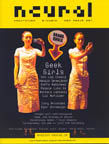
New Media Art, E-Music and Hacktivism
NEURAL n.24: new.media.art :: Shu Lea Cheang (interview) . Cory Arcangel (interview) . Barbara Lattanzi (interview) . Spam, the economy of desire . news: (Flickr Peep Show, PostSecret, Sequences, Mindbending, inc., Silver Cell). reviews: (Soviet-Unterzögersdorf, File Extinguisher, Miscalculator, Flying Spy Potatoes, Overheard in New York) . centerfold: Spin, liquid (tele)vision mediation
e.music :: People Like Us (interview) . Kaffe Matthews (interview) . Directional Audio sonic weapons and other stories . news: (TurntablistPC, Tenori-on, PDradio, Alvin, Speeds of Time) . reviews: (Christian Marclay, Essays on Radio, Sonic Fiction, 40 Canadian Propaganda Films, Buddha Machine, Visual Music, Sound Ideas; What Sound Does a Color Make?) . reviews cd: (Amon Tobin, Staalplaat Soundsystem, Kindermusik Taylor Deupree, Silicon Scally, Column One, Osymyso, Ssim-el, Port Doc 1- 5, Pierre Bastien, Dj Scotch Egg, Jason Kahn Bjorgulfsson / Ohlsson, DIY Canons, Maxence Cyrin, Leo...)
hacktivism :: Hack the Google self.referentialism . Natalie Jeremijenko interview . Igor Stromajer interview . The map is (not) the territory . news: (Shmoogle, Passfaces, Idiki, Netsukuku, Newsbreakers) . reviews: (Code, Engineering Culture, Making Things Public, Community Media, Everything is Under Control) . NEURAL
Posted by jo at 02:03 PM | Comments (0)
Rencontres internationales Paris/Berlin

Call for entries
11th and 12th festival Rencontres internationals Paris/Berlin: Call for entries - Deadline: April 30, 2006; Last deadline: May 15, 2006--The festival 'Rencontres internationales Paris/Berlin' present each year in the two cities a high level international programming dedicated to cinema, contemporary video creation and multimedia, gathering works by artists and directors recognized on the international scene along with younger or/and less known artists and directors.
Each year the 'Rencontres internationales Paris/Berlin', a non-profit event without competition, are the occasion to show these works to a large audience, to de-compartmentalize the different areas of creation and to make their viewers communicate, as well as to generate exchanges between artists, directors and participants of the artistic and cultural life.
The next 'Rencontres internationales Paris/Berlin' will take place in Berlin on early September and in Paris on late November 2006.
All individuals or organizations can submit one or several proposals to the programming team of the festival. The call for entry is open to cinema, video and multimedia cycles, without any restriction of length or genre. All submissions are free, without any limitation of geographic origins.
Film and video cycles
* Video Art / Experimental video – All video formats
* Documentary – All film and video formats
* Fiction / Short, medium and full length – All film and video formats
* Experimental Film – All film formats
* Animation movie – All formats
Multimedia cycles:
* Installation art
* Net art, CD-rom, DVD-rom
* Performance art, multimedia concert
Video and film proposals are received on DVD or VHS. ALL proposals are sent by mail, enclosed with a filled entry form, until April 30, 2006 - LAST DEADLINE: May 15th, 2006. The entry form as well as the information regarding the festival is available on our website or on demand by email: info[at]art-action.org
Posted by jo at 01:54 PM | Comments (0)
Melkweg

Dancing the Net
An installation and two performances at Melkweg: One Word Movie - Beat Brogle, Philippe Zimmermann I I 29 april t/m 4 june; OPENING: fri 28 april 20.00; We only do - Georg Hobmeier, Dance Unlimited I I 27, 28, 29 april, 20.30; CHIMERA - Evelien van den Broek, Muziekwerkplaats de Trampoline / 12, 13 may 20.30 EN 21.30
One Word Movie is an on-line platform which organizes, based on user-supplied terms, the flood of images on the Internet into an animated film. A word turns into images, images turn into a movie. This project plays with the tension between on-line and cinematic approaches to images. What images are associated with what words? «One Word Movie» reveals a glimpse into the „collective psychology“ of online cultures by showing patterns of word-image associations, as created by millions of people around the world.
WE ONLY DO researches the generic development of movement and performance structures. It is a network of choreographic structures (performed by a dancer), instructions (given by a computer) connected by rules and wireless headphones.
“eyeconed woeshoeshine,
choreogenetics and stagedicing,
3Dancers on their way to form,
plus veni vidi audi.....”
Georg Hobmeier (Austria) has a theatre background and works since some years within the new media collective 'Senselabor'. He is interested in how organisational structures come to exist within a choreography using live interactive media technology.
Choreogenetica: Georg Hobmeier | pure data, Computer Programming: Leo Lass; Audio: Gregor Ladenhauf | Dance: Nina Fajdiga, Vlasta Veselko, Jadi Carboni. We Only Do is a graduation project of Dance Unlimited, Amsterdam Hogeschool vd Kunsten (AHK).
CHIMERA is a conversation between chant and dance. A singer communicates by her voice, a dancer by her body, influencing one another by their mutual actions. The dancer making the unvisible audible, thus forming a soundscape of both abstract and conventional language. Gentle sounds exagerated by the gestures of the dancer and sent through the space like floating airbubles. A videocapturing system will interpret movements into sound.
Composition & Singing: Evelien van den Broek; Choreografy & Dance: Eva Baumann; Software Programing & Sound: Boban Bajic; light: Minna Tiikkainen o.v.; Artistic Advise: Robert Steijn; Production: De Trampoline, Melkweg.
lucas evers
www.melkweg.nl
lijnbaansgracht 234 a
1017 ph amsterdam
+31 20 5318181
Posted by jo at 01:40 PM | Comments (0)
Receiver Magazine, #15
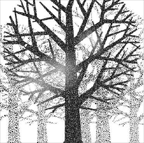
Wish You Were Here
Receiver Magazine, #15: We always take the mobile with us because we want to be reachable. But who do we want to be reachable for? Take a closer look: primarily for those we love. Apart from using them for work-related purposes, mobile phones are a great source of strength for our inner circle - they connect us to those stored in the handset's contact list whom we want to reassure that we are with in spirit, and who know when we might need the emotional support of a quick text. This receiver issue is all about that yearning factor that comes with using the mobile phone, about the meta-message which is always present: 'wish you were here'.
Vodafone's receiver magazine is a neutral space where pioneer thinkers challenge you to discuss exciting, future-oriented aspects of communications technologies. Started over five years ago as a platform for exchange about how innovations in this sector affect societies worldwide, receiver is now established as one of the industry's key idea generators.
Articles:
Jane Vincent: I just can't live without my mobile!
Could it be that we are not only emotional about the ones we keep in touch with, but that we have come to assign an emotional quality to the handset itself? Jane Vincent, whose paper is the opener for our 'Wish you were here' issue, thinks so! She has worked in the mobile communications industry since 1982. A Research Fellow with the Digital World Research Centre at the University of Surrey, Vincent's main interest is in user behaviours associated with mobile communications. She has long pondered over the one and crucial question: 'How come we feel emotionally attached to our mobiles?' and presents some of her findings here in receiver.
Rich Ling: Nomos and the flexible coordination of the family
Rich Ling is a Senior Research Scientist at the research and development division of Telenor, Norway's largest research establishment within information and communication technology. Ling, who investigates the social impact of mobile telephony, is a most influential writer on mobile matters, serving on the editorial boards of a number of academic journals. He authored The mobile connection - the cell phone's impact on society, a book published by Morgan Kaufman in 2004. Read Ling's article for receiver to learn how mobile communication contributes to the maintenance of the family as an institution.
Ruth Rettie: How text messages create connectedness
Ruth Rettie is an ex-Unilever Brand Manager who is currently a senior lecturer at Kingston University in London. At the University's Business School she lectures on internet marketing, E- and M-commerce and has a strong research interest in communication theory. She is currently completing her PhD in sociology at the University of Surrey, which focuses on mobile phone communication. In her receiver contribution, Rettie explains how connectedness is a premier driver of mobile communication.
Tim Kindberg: We are cameras - image acts in personal interaction
Tim Kindberg, a senior researcher at HP Labs Bristol, UK, with a strong interest in nomadic and urban computing, has recently focused on the usage of camera phones. He and colleagues at HP Labs Palo Alto (Mirjana Spasojevic) and Microsoft Research Cambridge, UK (Abigail Sellen and Rowanne Fleck) carried out an in-depth study into camera phone use in the UK and US. Findings: people often have strong social or sharing intentions when capturing a picture, but typically use 'capture and show' rather than 'capture and send'. Read Kindberg's receiver contribution to find out more about the social uses of camera phones.
Jeff Axup: Blog the World
Jeff Axup is a PhD candidate at the University of Queensland in Brisbane, Australia. His research in Mobile Community Design focuses on the development and design of mobile devices used by groups and how device design might change group behaviour. Axup has chosen to look at one highly mobile group in detail and examines what technologies could be used to support backpackers. Read his receiver contribution to find out about the usage patterns and demands he came across with a group of people who to a large extent depend on forming social networks while on the move.
Joachim R Höflich: The duality of effects - the mobile phone and relationships
Joachim Höflich is Professor of Communication Studies at the University of Erfurt, Germany. He has been looking at forms of media-driven interpersonal communication for many years. His particular focus is mobile communication, and he has written and edited a number of books including Mobile Kommunikation (2005) and Mobile Communication in Everyday Life, which will be published shortly. In his contribution to receiver, Höflich weighs up the positive and negative effects of mobile phones as a medium for relationships and takes a look at the particular way in which relationships are affected by them.
Pierre Proske: Bleating in the bank queue
Pierre Proske is a Melbourne-based programmer and digital artist with a background in music, engineering, literature and performing arts. Proske's artistic work focuses on people's relationships with technology, his most recent example being True Blue Love. This mobile phone based mating experiment was launched at last year's Mobile Journeys exhibition in Sydney, a venture that explores the creative potential of Australian mobile culture. In Bleating in the bank queue, Proske introduces us to his match-making project which plays with an inversion of the silent communications that mobile phones promote.
Mark Federman: Memories of now
Mark Federman is completing a PhD at the University of Toronto, researching the future form of corporations in a ubiquitously connected and pervasively proximate world. Over the last five years, Federman has been Chief Strategist at the McLuhan Program in Culture and Technology at the University of Toronto and is co-author, with Derrick de Kerckhove, of McLuhan for Managers. His receiver contribution tells us, in his own and in McLuhan's words, how we have focused on sharing the "here and now" since we learned to use tools that enable ubiquitous communication.
Nicola Döring: Just you and me - and your mobile
Nicola Döring is Professor of Media Design and Media Psychology at Ilmenau University of Technology, Germany, where she researches psychological and social dimensions of new communication technologies. She has published widely on online and mobile communication, focusing on communities, language, learning, identity, gender, sexuality, romance and interpersonal relationships. In her receiver contribution, Döring takes a closer look at mobile phone interruptions during romantic dates and meetings with friends based on an observational study.
Posted by jo at 01:23 PM | Comments (0)
Barszcz.net
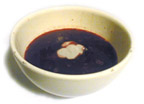
Gourmet programming
'Barszcz' [often written 'Borscht'] is a traditional Eastern and Central European soup of red beetroot that comes in many regional and seasonal varieties. The 'Barszcz.net' website presents a recipe for Ukrainian Barszcz and a first contribution to its source code repository: Jaromil's 'string based cooking' written in the programming language C.
Barszcz.net stresses the parallel between programming and recipes in a cookbook as a set of instructions to follow. Like cooking recipes, examining the source code of a particular program reveals information about the software in much the same way as the ingredients and set of instructions of a recipe reveals information about the dish to be prepared. The analogy reveals something of the interests involved in the preparation, execution and consumption of the (software) work. Both programming and cooking can express intentionality, style and should be accompanied with a health warning. All source code/recipes submitted to the repository are released under the GNU General Public License.
Barszcz.net is looking for further entries to add to the repository in a range of programming languages. If you have any barszcz source code that you would like to share, please email 'info at barszcz.net' (replace word for symbol before sending).
Barszcz source code repository http://www.barszcz.net
Posted by luis at 04:26 AM | Comments (0)
April 23, 2006
World of Awe
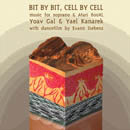
Bit by Bit, Cell by Cell
After five years in the making, the first World of Awe Enhanced CD is released by Innova label. Bit by Bit, Cell by Cell will be in stores by May 23 and is already available at the Eyebeam bookstore.
"Remember the Atari and the dawning of computer game technology? Well, it's back, not with a vengeance but as an intense musical tool for an enigmatic Postmodern opera out of New York City known as Bit by Bit, Cell by Cell. The fantastical production is a team effort of media artist Yael Kanarek, composer Yoav Gal, and dance-filmmaker Evann Siebens, packaged as an enhanced CD collectible art-object designed by Mushon Zer-Aviv. Together, it is a World of Awe production, helped along by a residency at Harvestworks. And what a production it is. The plot (in itself an award-winning narrative) revolves around a lone traveler who searches for a lost treasure in a parallel world. Finding a portal in front of 419 East 6th Street and performing a dance right there in the street (see it when you place the CD in your computer), the hooded traveler escapes toward Sunset/Sunrise...The rest is unclear but beautiful, striking in its mystery: Excerpts from the traveler's journal are set to the processed voice of soprano Sarah Rivkin combined with the sounds of the lost world/old-school of the Atari 800XL to convey the traveler's different moods, and create the musical topography of World of Awe..."
Posted by jo at 02:09 PM | Comments (0)
Garrett Lynch and Frederique Santune
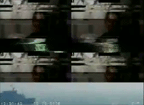
Three Collaborative Networked Videos
Collaboration for artists can be one of the most productive endevours. It produces work by the artists involved which would have unlikely been produced individually and also obliges the artists to make conceptual compromises they might not usually have to. It frees up the creative spirit as each artist realises at a point that they have to let go of their single vision to accommodate the thinking of the other. The OTHER is the crucial element in collaboration, it not alone designates the other artist but also implicates the unseen, inexperienced, unknowable, unthinkable and inconceivable of the former
Under this framework Garrett Lynch and Frederique Santune would like to announce the release of three networked performance video collaborations entitled Grimace, C.a.r.n.e.t. . .d.a.b.o.r.d, and Looping Portrait #1. Each work was performed live employing multiple digital video cameras networked and mixed through a camera security system.
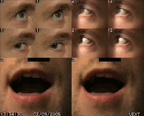
Grimace is a studio based performance employing three digital video cameras networked to a multiple camera security system. The two faces displayed are a reconstruction of artist Garrett Lynch's face. Two camera video his eyes while the third camera videos his mouth. The live feed of each of the eyes are then used eight times with a set of four right eyes on the left of the screen and a set of four left eyes on the right of the screen. Two identical live feeds of the mouth are displayed below each set of eyes. The resulting composition is of two faces bearing a close resemblance yet differing slightly, reacting, grimacing, to some unseen event or in response to each other.
C.a.r.n.e.t. . .d.a.b.o.r.d: C’est l’histoire courte d'un passage: du pareil au même. Quand le doute devient errance, la voix se perd.
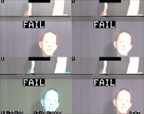
Looping Portrait #1 is an accidental portrait of artist Frederique Santune produced during setup of a studio based performance. It consists of two digital video cameras networked to a multiple camera security system which mix's them live to a single digital video deck. The cameras are off-sync with the security system resulting in distortion, regular loss of signal and a progressive scanning of the video from right to left. This effect combined with the figures movement create potential for an infinite and seamless video portrait.
Posted by jo at 01:53 PM | Comments (0)
PORTA2030
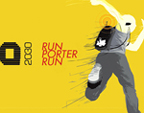
YOU ARE PORTA-PORTER!
April 24 - May 1, 2006 BROADWAY MARKET, London: PORTA2030 is a performative urgency-relay network exercises set within Broadway Market public wifi net-zone. Towards building a portable, sustainable and responsive social network by year 2030, PORTA2030 engages community members as porta-porters for an urgency scenario enactment.
PORTA2030 deploys porta-pack, a mobile network unit that builds on a wifi harddrive (WL-HDD2.5) for multi-faceted transmission. Installed with a 1GB flashcard and programmed in open source codes, the porta-pack functions as a portable data sensing-storage-tranmission unit. A webcam streams images live while an LCD mini-terminal with 4 click action push buttons serve as basic communicative device. The urgency signals triggered by the sensors set in public space further prompt porta-porters' collective action.
Broadway Market (E8, London), known as Market Porters' path for porting produce into the city, is currently under rapid development affected by Hackney Council's regeneration plan. For last two years, physical Porters' Path is implemented with wireless extension provided by the OFF Broadway gallery. PORTA2030 locates Broadway Market as its public performance site with setup of extra access nodes. PORTA2030 updates the porter's path with mobile network porting of communal audio/visual data.
Weeklong performance starts on April 24 with porta-pack dispatch workshop at SPACE media center. During the week, 10 porta-porters engage in networked ommunication. April 29, Broadway market, Porta2030 relay bingo play. May 1, May Day - public screening session with open-air projection: Porta-porters' week and Broadway market related documentaries. For further information please contact now[at]take2030.net
Posted by jo at 01:09 PM | Comments (0)
April 22, 2006
Esthétique Rélationnel

Antagonism and Relational Aesthetics
"...It is important to emphasize, however, that Bourriaud does not regard relational aesthetics to be simply a theory of interactive art. He considers it to be a means of locating contemporary practice within the culture at large: relational art is seen as a direct response to the shift from a goods to a service-based economy.10 It is also seen as a response to the virtual relationships of the Internet and globalization, which on the one hand have prompted a desire for more physical and face-to-face interaction between people, while on the other have inspired artists to adopt a do-it-yourself (DIY) approach and model their own “possible universes” (RA, p. 13). This emphasis on immediacy is familiar to us from the 1960s, recalling the premium placed by performance art on the authenticity of our first-hand encounter with the artist’s body. But Bourriaud is at pains to distance contemporary work from that of previous generations. The main difference, as he sees it, is the shift in attitude toward social change: instead of a “utopian” agenda, today’s artists seek only to find provisional solutions in the here and now; instead of trying to change their environment, artists today are simply “learning to inhabit the world in a better way”; instead of looking forward to a future utopia, this art sets up functioning “microtopias” in the present (RA, p. 13).
Bourriaud summarizes this new attitude vividly in one sentence: “It seems more pressing to invent possible relations with our neighbors in the present than to bet on happier tomorrows” (RA, p. 45). This DIY, microtopian ethos is what Bourriaud perceives to be the core political significance of relational aesthetics..." From Antagonism and Relational Aesthetics by Claire Bishop [PDF] [via] [Related 1, 2, 3]
Posted by jo at 11:02 AM | Comments (0)
Ars Virtua Gallery & New Media Center
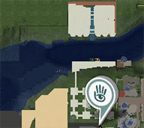
Opening of "The Real"
Ars Virtua Gallery & New Media Center invites the public to the opening of it's inaugural show entitled The Real. The event will be held on the grounds of Ars Virtua which can be found here in the 3d rendered world of Second Life. Six artists are represented in this show which examines the nature of observation, movement, communication, contact, and fetish in the virtual environment of the avatar.
These investigations form the basis of questioning what is real, they go beyond the experience of the user at the keyboard to reference that similar and familiar experience of the driver behind the wheel. The metaphor remains consistent between the two. The answers we arrive at are not surprising and are no more profound than the pen on your desktop.
The show runs from April 28 through June 23, 2006 with the opening and artist's reception at 7pm SLT (Pacific Daylight Time) on April 28. Inquiries to gallery[at]arsvirtua.com [Related 1, 2, 3, 4, 5]
Posted by jo at 10:46 AM | Comments (0)
Performance Studies international #12:
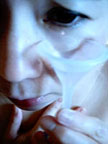
Performing Rights
Performance Studies international (PSi), in collaboration with Queen Mary, University of London, East End Collaborations and the Live Art Development Agency announce the opening of registration for their major international conference and performance festival Performing Rights which takes place across the East End campus of Queen Mary, University of London, from June 14 – 18, 2006.
To register for the conference (and take advantage of early booking rates) go to: http://www.psi12.qmul.ac.uk
Performance Studies international (PSi) is an international powerhouse of innovation for academics, artists and activists, holding annual conferences across the globe. In London for the first time, PSi 12 will focus on questions of performance and human rights and will feature plenary addresses, numerous panels and commissioned performances, a diverse programme of challenging and innovative live art and theatre, practical workshops, a space for debate and presentations, and the making of an archive of performance activism in support of human rights.
Bringing together curators, policy makers and directors of some of London’s key cultural agencies and institutions, alongside artists, activists and thinkers from all over the world, this event will be a unique crossing between the arts, the academy, activism and public policy. Human rights are too important to leave to the politicians. How does performance practice and thinking open up new possibilities for the understanding, enactment and sustenance of human rights? Queen Mary, University of London will become an open, public platform where the making and unmaking of human rights can be debated and performed.
Participating artists, activists and writers include: Irene Khan (Secretary General of Amnesty International), Guillermo Gomez-Peña, Peggy Phelan, Luiz Eduardo Soares (former Brazilian Minister for Public Security) John Jordan, Karen Finley, Jon McKenzie, Lois Weaver, William Pope.L, Goat Island, Coco Fusco, Alan Read, Nao Bustamante, Amelia Jones, Zai Kuning, Bobby Baker, Baz Kershaw, Naeem Mohaiemen, Curious, Gustavo Ciriaco, Luiz De Abreu, Leibniz, Peggy Shaw, Chumpon Apisuk, Paul Heritage, Anjalika Sagar and Kodwo Eshun of the Otolith Group, Rebecca Schneider, Richard Dedomenici, Janelle Reinelt, Gavin Butt, Stacy Makishi, Monica Ross, Rabih Mroue, Adrian Heathfield, Diana Taylor, Franko B, Freddie Rokem, Carol Becker, Jose Esteban Munoz, Peta Tait, Mike Pearson, Jen Harvey, Yara El Sherbini, Adrien Sina, Oreet Ashery, Reem Fadda, Nick Ridout, Una Chaudhuri and Eduardo Bonito.
The conference will present the work of participants from over thirty different countries including: Brazil, USA, Egypt, Israel, Bangladesh, Japan, Malaysia, Indonesia, Singapore, Australia, Austria, Turkey, Denmark, Croatia, Romania, Germany, France, UK, Ireland, Mexico, Lebanon, Morocco, Greece, India, Pakistan, Taiwan, China, the Czech Republic, Finland, Argentina, Canada, Nigeria, Switzerland, Italy, and Zimbabwe.
Over four hundred participants are anticipated for this conference and hundreds more will come to the galleries, installations, performances and workshops that will be run throughout the four days.
Here you will also be able to access on-campus accommodation details and booking. Full details of the schedule of panels, presentations, installations and performances will be available closer to the time. Registration at the conference includes membership of PSi for 2006.
Posted by jo at 10:08 AM | Comments (0)
SITELINES 06
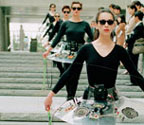
AUDIO BALLERINAS
AUDIO BALLERINAS by Benoît Maubrey and Die Audio Gruppe at SITELINES 06, May 8 through 13, 2:30 pm; Venue: Elevated Acre at 55 Water Street, New York City; Admission: free.
Benoît Maubrey is the founder and director of DIE AUDIO GRUPPE a Berlin-based performance group that build and perform with electroacoustic (“sounding“) clothes. Basically these are electro-acoustic clothes, costumes and uniforms (equipped with batteries, amplifiers and loudspeakers) that create sounds by interacting with their environment. The Audio Gruppe's work is essentially site-specific. Usually the electronics are adapted into entirely a new "audio uniform" or "sonic costume" that reflect a local theme (AUDIO HERD, AUDIO CYCLISTS, AUDIO STEELWORKER, VIDEO PEACOCKS, AUDIO VACUUM CLEANERS) or customs and traditions (AUDIO GEISHAS/Japan, AUDIO CYCLISTS/France, AUDIO HANBOK/Korea).
The AUDIO BALLERINAS, initially conceived in 1990 for the festival LES ARTS AU SOLEIL in France where they used solar cells to power their Audio Tutus, have since developed a variety of choreographies using electronic instruments (digital samplers, light sensors, contact microphones, music sticks, and radio receivers) that allow them to work with the sounds, surfaces, electro-magnetic waves and physical topography of the space around them. The AUDIO BALLERINAS will be presenting 3 site-specifically adapted choreographies: the LINE (contact microphones and music sticks), PEEPERS (light-to-frequency sensors), and YAMAHA (movement sensors that trigger digital sounds). Alternative: APPLE RADIOS (solar cells and white noise).
Benoît Maubrey was born of French parents in 1952 in Washington D.C. and graduated from Georgetown University in 1975. After working as a writer and painter and jobbing as hotel concierge in Bordeaux, Paris, New York and Washington DC, he moved to West Berlin in 1979 where he starting building Audio Clothes in 1982. After the fall of the Berlin Wall in 1992 he moved to the village of Baitz in former East Germany. His performance and sound art installations have been presented at many international festivals around the world.

The SiteLines performances are choreographed by Mimi Messner (Berlin). Local dancers and assistants: Faith Pilger, Andrea Lieske, Samantha Speis, Eline Tan, Violette Olympia, Mira Mutka, Anna Whaley, Micah Killion, Herb Hernandez
Contacts: Benoît Maubrey, Bahnhofstr. 47, 14806 Baitz Germany tel
+49-33841-8265 fax: +49-33841-33121 cell phone in USA 202 374 4614
Lower Manhattan Cultural Council: Nolini Barretto tel: 212-219 9401 X119
This work was made possible, in part, by Franklin Furnace Fund for Performance Art, supported by Jerome Foundation in celebration of the Jerome Hill Centennial and in recognition of the valuable cultural contributions of artists to society.
Posted by jo at 09:10 AM | Comments (0)
Portuguese Festival of Performance and Visual Art
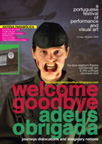
Welcome Goodbye Adeus Obrigada: Journeys dislocations and imaginary nations
Welcome Goodbye Adeus Obrigada brings together artists that use journeys and imaginary places as the departure for their work. Their projects share references to tourism, migration and new geographies, encouraging speculations about the existence of a third space: a hybrid territory developing from transnational encounters and cross-border dialogues embedded in the fabric of day to day life.
Their work takes place in and around the Blue Elephant Theatre in Camberwell and Little Portugal, the name given to Stockwell's thriving Portuguese in the heart of south London. The programme brings together Portuguese artists living in Lisbon and the UK for the first time.
Welcome Goodbye Adeus Obrigada: Journeys dislocations and imaginary nations--Portuguese Festival of Performance and Visual Art; 3 May to 30 June
Blue Elephant Theatre, 59a Betwhin Rd Camberwell SE5 0XT.
Posted by luis at 08:09 AM | Comments (0)
Sound performance in London
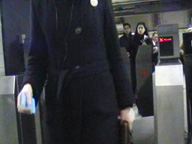
Arphield Recordings
Arphield recordings is a project documenting sound performed with RFID (arphid) technology, the radio frequency identification system used for access control and surveillance. The microchip inside each Oyster card tracks your journeys, beeping every time you enter or exit the tube. Join the mob at the Stockwell tube station for an impromptu sound jam/memorial using your oyster cards. 10 June 2006 at 14pm. Download the arphield Recordings podcast from http://odeo.com/channel/85358 and bring the sounds on a portable music player to experience a mix of live and prerecorded Oyster beeps.
The project started with the idea for an arphid mob, inviting friends to join the artist at a designated tube station for a semi-coreographed sound jam using oyster cards. The main question was ‘when and where’ as a major impediment would always be the heavy security at all the gates. It was decided the artist would do some observation and this would eventually indicate the best timing and location for the arphid mob. Observing the familiar tube’s access control gates, initially with no equipment and later with a video recorder, she realised that people were already engaging in impromptu sound performances. My documentation led me to discern varied patterns and even participatory scores, with mass arphid soundscapes punctuated by silences, glitches and cracks in the system, all warped up in a circadian rhythm of work-rush hours.
The first arphield recordings –documenting the impromptu sound performance of people moving through the London tube access control gates were done in Brixton, Kings Cross and Caledonian Road tube stations during march 2006 for the TAGGED one day event at SPACE Media Arts (NodeLondon March 2006), when cds with the tracks and locational tags were distributed.
The project remains open to contributions. One way of doing this is downloading the arphield recordings and visiting the station gates with the sounds on a portable music player to experience a mix of live and prerecorded oyster beeps. Another way of participating is by contributing arphield recordings from a tube station access control gate. You can do this by opening an odeo.com account and uploading your recordings, tagging them as arphieldRecording followed by the number unique to your oyster card (as in arphieldRecordings-0503266130-03)
The next arphid mob will happen at the Stockwell tube station, South London. Join us for an impromptu sound jam/memorial using our oyster cards, on Portugal day,the 10th of June 2006 at 14pm. Download the arphield Recordings podcast from http://odeo.com/channel/85358 and bring the sounds on a portable music player. Part of Welcome Goodbye Adeus Obrigada, a Portuguese festival of theatre and visual arts at the Blue Elephant Theatre and the Little Portugal.
Posted by luis at 07:36 AM | Comments (0)
Gao Zhen and Gao Qiang
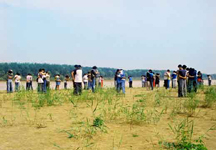
THE UTOPIA OF HUGGING
The Utopia of Hugging: A performance by the Gao Brothers from Beijing at Arboretum Park, Nottingham/UK, SUNDAY APRIL 30, 2006 FROM 11:30 AM. A video of the Nottingham Hug will be online 3 hours later [14:30 GMT] at
As part of their global World Hug Day performances, internationally renowned Chinese artist brothers Gao Zhen and Gao Qiang invite you to participate in the most ambitious event of the series to date; a group embrace of epic proportions orchestrated at the Networking Artists Network [NAN] conference and representing the first ever mass hugging to be staged in the British Isles.
Volunteers wishing to take part in the performance are invited to come to Arboretum Park where they will be directed with hundreds of others by the Gao Brothers to embark on a hearty fifteen minutes hug with a stranger, followed by one gigantic hugging cluster formed by the entire group, all accompanied by the music of J.S. Bach. Speaking about their first performance of a group hug THE UTOPIA OF HUGGING [Shangdong Province, China, September 2000] the Gao Brothers explain:
"We invited some 150 volunteers, who were previously strangers to each other, to participate. We asked the participants to choose a person at random for a hug, which they would then do simultaneously with hundreds of other couples. We then asked everyone present to cluster into one big group hug. Since then, we personally have hugged hundreds of strangers, and organised group hugs amongst strangers in different public locations and in different ways all across China."
World Hug Day series will continue in Marseille on the 9th of June, running concurrent with an international travelling photo exhibition documenting all performances so far.
The event will be followed by a press-conference / presentation with the Gao Brothers and their co-organsing partners from artists group Digital Art Projects at the nearby Waverley lecture theatre of Nottingham Trent University from 12:30 onwards.
Posted by jo at 07:13 AM | Comments (0)
April 21, 2006
Allan Kaprow
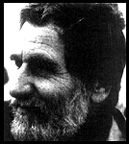
Creator of Artistic 'Happenings,' Dies at 78
Allan Kaprow, Creator of Artistic 'Happenings,' Dies at 78 by HOLLAND COTTER, April 10, 2006, The New Yok Times.
Allan Kaprow, an artist who coined the term "happenings" in the late 1950's and whose anti-art, audience-participation works contributed to radical changes in the course of late-20th-century art, died on Wednesday at his home in Encinitas, Calif., near San Diego. He was 78.
He died of natural causes after a long illness, said Tamara Bloomberg, his studio manager.
Mr. Kaprow was born in Atlantic City and began his career as an abstract painter in New York City in the 1940's, studying with Hans Hofmann. Inspired by the swirling drips and spatters of Jackson Pollock, and focusing on the idea of the painting as a physical event rather than as the production of an object, Mr. Kaprow pushed the "action painting" aesthetic in multimedia directions, at first by bulking up his canvas surfaces with hunks of straw and wadded newspapers and adding movable parts that viewers were invited to manipulate.
He called the results "action collages" and predicted, in a 1958 article in Art News, that in the art of the future action would predominate over painting and an increasing array of materials would come into play, including "chairs, food, electric and neon lights, smoke, water, old socks, a dog, movies, and a thousand other things." His own collages began to develop into room-filling environments that would pave the way for the installation art and performance art of today.
Along with Pollock, Mr. Kaprow's other great influence was the composer John Cage, with whom he studied from 1956 to 1958 at the New School for Social Research. He was particularly interested in Cage's Zen-inspired reliance on chance as an organizing, or disorganizing, element in art. Like Cage, he used a combination of choice and accident as a way of creating nonverbal, quasi-theatrical situations in which performers functioned as kinetic objects, the role of the single artist-genius was de-emphasized, audience members became creative participants, and no clear distinction was made between everyday actions and ritual.
The first such work, "Eighteen Happenings in Six Parts," took place in October 1959 at the Reuben Gallery in Manhattan, which Mr. Kaprow had co-founded. Although later the term "happening" would come to mean spontaneous, celebratory group behavior, Mr. Kaprow's early events were scripted assemblages of movement, sound, scent and light, with instructions given to performers and viewers alike. In the October 1959 version, spectators moved, on cue, to different parts of the gallery to experience a woman squeezing oranges, artists painting and a concert played on toy instruments.
Throughout his career Mr. Kaprow, who referred to himself as an "un-artist," created happenings outside galleries and museums, in lofts, stores, gymnasiums and parking lots. An element of absurdity was never far away: with the assistance of viewer-workers, he built houses from ice in Southern California and, in 1970, constructed a wall of bread with jelly as mortar near the Berlin Wall.
Mr. Kaprow was only one of the several artists involved in inventing happenings as a form: Jim Dine, Red Grooms, Claes Oldenburg, Robert Watts and Robert Whitman continued to use it. But he eventually stopped creating large public events in favor of what he called "activities" — intimate, personal pieces for a small number of participants. People in pairs, for example, would breathe into each other's mouths, or sweep the street, or go shopping.
In some case, Mr. Kaprow himself was the sole participant and audience, as in a 1980's piece that focused on the details of his daily tooth-brushing at home. He documented these private works in small booklets of instructions that read like Concrete poetry.
As an undergraduate at New York University, Mr. Kaprow was much influenced by John Dewey's book "Art as Experience." He did graduate work in art history at Columbia University with Meyer Schapiro, for whom he wrote a master's thesis on Mondrian. He taught at Rutgers University, Pratt Institute, the State University of New York at Stony Brook, California Institute of the Arts and, from 1974 to 1993, the University of California at San Diego.
He was a prolific and personable writer, and much of his work is collected in "Essays on the Blurring of Art and Life," edited by Jeff Kelley and published by the University of California Press in 1993. Mr. Kelley's book on the artist, "Childsplay: The Art of Allan Kaprow," was published by the same press in 2004.
That book has a foreword by the poet and performer David Antin, a longtime colleague of Mr. Kaprow, in which Mr. Antin describes a piece from the late 1980's that required a participant to carry cinder blocks, one at a time, up five flights of stairs, then down again. The number of blocks corresponded to the carrier's age. "I know that Allan sees his work as 'un-art,' " Mr. Antin concludes, "and wants to see its separation from art, envisioning it as simply an articulation of meaningful experiences from ordinary life. I'm sympathetic to this intention, but I find it hard to distinguish the existential power of this piece, which now exists only in the telling, from that of any other great work of art I've ever encountered."
Mr. Kaprow is survived by his second wife, Coryl Crane; two sons, Bram, of Encinitas, and Anton, of Altadena, Calif.; two daughters, Amy, of Berkeley, Calif., and Marisa, of Pacific Beach, Calif.; and three grandchildren.
Posted by jo at 06:02 PM | Comments (0)
Willy Le Maitre

Edia and Context Gardens
Saturday, April 22nd, 7pm at The Workman Theatre, 1001 Queen Street West, Toronto: Images 06 will be premiering Edia and Context Gardens, two new works by Toronto based media artist Willy Le Maitre. Both are performed cinema presentations that utilize stereographic video projection. The image is comprised of real time manipulations of volumetric scenes in conjunction with prepared segments of stereo-video. The navigable form of the projected audio and video provide a unique iteration of the work at each viewing.
Edia presents a dynamic psychological space. Resembling a hybrid diagram of molecular structures and astropataphysic theory; the visualization continuously reconfigures itself through the discrete interactions of its¹ constituent parts. Myriads of particles that swarm, hover, interpenetrate are coated in video texture. Through them we glimpse into images of distinct and diverse subject spaces. The spaces segue, meshing one place into another. Where Edia evokes a biological dimension to image; it does so in its¹ depiction of multifaceted matter being foremost a carrier of energy that characterizes reality as being primarily; a play of forces.
Context Gardens is a stereographic visualization of being between cosmos and the quanta. At the center of Context Gardens; the audience converges to board a craft, understood as time. Context Gardens configures an image space in an ecliptic of emergent archetypal influences that exert a tidal power over craft. Charged with event radiation; sonic gas permeates the scene while tiny vesicles form a battery of chemical messengers; conjuring memory¹s image channel. Time is shown volumetrically and revealed to be circular, its¹ present vectored to every past.
Willy Le Maitre has created media art works since 1988. He has been oriented to video as a live form that has served as a pivot point in collaborations between him, musicians, writers and other visual artists. Currently based in Toronto he enjoyed a creative dialogue for over 10 years with New York based composer Eric Rosenzveig. Located in different cities their collaborative system was incubated over the network. Notably with The Appearance Machine; an autonomous system that generated media assets and content streams from the reanimation of consumer refuse and distributed its live results to logged galleries. More recent efforts involved the development of Playlist, a collaborative authoring application and its compliment; disPlaylist a 3d visualization of the multi-threaded media work created collectively by a number of media artists using Playlist. His work has been presented, among other places, at The New Museum, the Kitchen, FIMA in Victoriaville Qc., ICMC in Banff Canada and ISEA. The work has received numerous grants and awards including LIFE 3.0 competition for artificial life artworks and The Telefilm Canada prize at Images Festival of Independent Film, 2000, Toronto.
Posted by jo at 11:10 AM | Comments (0)
Away From the New
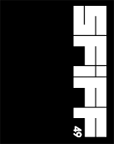
Blow at Phone to Guide Your Boat
Following their Organum Playtest game, Niemeyer, Perkel and Shaw are presenting their new game Away from the New at the San Francisco International Film Festival, on April 27, 6:30pm, Kabuki Theater. Away from the New takes its players back in time from 1922AD to 622AD. Blowing into their cell phones, players propel their faluka (a small Egyptian sailboat) along the Nile. Their mission is to steer the sailboat clear from the shore, and to rescue swimming babies throughout their journey.
Dodging faluka-eating crocodiles and loading rescued babies onto bigger rescue boats creates unique challenges. The object of the game is to return all babies to safety at the end of the last level. All level designs are based on ancient records of Nile river levels.
On April 27, 6:30pm at the Kabuki Theatre in San Francisco, you will have the opportunity to observe and play "Away from the New" as the game attempts to visualize and vocalize the timeless interaction between humans, nature, and their quest for balance.
Posted by jo at 10:43 AM | Comments (0)
April 20, 2006
Adam Greenfield

Everyware Discussion on Well
The Well's Inkwell Conference, which is open to the public, features a discussion with Adam Greenfield, author of Everyware, an excellent new book about the implications of ubicomp:
Computing devices shrink ever smaller and become invisible, while at the same time we interact with them and they communicate with one another. Rather than carrying phones and PDAs, our desks, rooms, and clothing, our food and our sex toys converge, interconnect, and interact. Their connectedness is hidden from us, we don't control the information they record, and there's no "Undo" key.
"Great, another loopy novelist in the Inkwell, extrapolating from a random headline in a trade journal," you say.
It's not loopy fiction, according to Adam Greenfield. Instead, it's the form computing will take in the next few years, and it behooves us to think it through in advance, in order both to understand it and humanize it. That's the subject of "Everyware: The dawning age of ubiquitous computing."
Join Adam Greenfield from the beginning of the conversation or catch up on the latest posts. [posted by Howard on Smart Mobs]
Posted by jo at 12:54 PM | Comments (0)
DATA Browser 03

Curating Immateriality
The third book in the DATA Browser series of critical texts that explore issues at the intersection of culture and technology has just been published. The site of curatorial production has been expanded to include the space of the Internet and the focus of curatorial attention has been extended from the object to processes to dynamic network systems. As a result, curatorial work has become more widely distributed between multiple agents, including technological networks and software. This upgraded 'operating system' of art presents new possibilities of online curating that is collective and distributed - even to the extreme of a self-organising system that curates itself. The curator is part of this entire system but not central to it. This book reflects on these changes and examines the work of the curator in relation to a wider socio political context articulated through two key issues: immateriality and network systems. It considers how the practice of curating has been transformed by distributed networks beyond the rhetoric of free software and open systems.
Contributors:
0100101110101101.ORG & [epidemiC] | Josephine Berry Slater | Geoff Cox |
Alexander R. Galloway & Eugene Thacker | Olga Goriunova & Alexei Shulgin |
Beryl Graham | Eva Grubinger | Piotr Krajewski | Jacob Lillemose | low-fi |
Franziska Nori | Matteo Pasquinelli | Christiane Paul | Trebor Scholz |
Grzesiek Sedek | Tiziana Terranova | Marina Vishmidt
For more information see http://www.data-browser.net/03/
Title: CURATING IMMATERIALITY: THE WORK OF THE CURATOR IN THE AGE OF NETWORK SYSTEMS
Authors: Various contributors, edited by Joasia Krysa
Publisher: Autonomedia (DATA browser 03)
Copyright: 2006 (all texts released under a Creative Commons License)
ISBN: 1-57027-173-9
Pages: 288, Paper Perfectbound
The DATA browser series presents critical texts that explore issues at the intersection of culture and technology. The editorial group are Geoff Cox, Joasia Krysa, Anya Lewin, Malcolm Miles, Mike Punt & Hugo de Rijke. This volume is produced in association with Arts Council England and University of Plymouth.
Posted by luis at 12:10 PM | Comments (0)
Anne Galloway
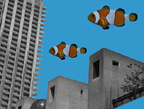
LOCATION-AWARE TECHNOLOGIES, SPATIAL-ANNOTATION, AND THE FATE OF URBAN COMMUNITY
Location-aware technologies such as GPS and RFID are increasingly being used for a variety of European and North American urban spatial-annotation projects. These desires to “tag” the world-around-us, I argue, can be understood as particular intensifications and materialisations of Western political longings for unified community in times of fragmentation and diversity. But what senses of belonging are we presupposing when we attempt to bind collective memories to singular places? And what kind of community is possible when the technologies and protocols that underpin such projects may be understood, following Mackenzie, as 'kludge' or an 'ill-assorted collection of poorly matching parts, forming a distressing whole'? Borrowing concepts from Giorgio Agamben, Jean-Luc Nancy and Marc Augé, I explore tensions between mobility and dwelling, difference and commonality, memory and forgetting. Accordingly, questions concerning political and ethical participation, and the role of affective encounters such as alignments, identifications and appropriations take on special force. Ultimately, it is my position that any kind of technologically-enabled communalism or collective memory that privileges unity and order threatens to undermine the senses of contingency and potentiality necessary for a politics of hope in everyday urban life. [blogged by Anne on Purse Lips Square Jaw]
Posted by jo at 11:30 AM | Comments (0)
UNESCO DigiArts International call for participation
![]()
Scenes and Sounds of my City
International call for participation - Scenes and sounds of my city: Special Session 2006 - Deadline for submissions 3 May 2006
The UNESCO DigiArts Team invites young students and teachers to reflect on the theme of “scenes and sounds of my city” and to send to UNESCO a joint project proposal in group work that focuses on a specific topic or issue in relation to their urban environment or their experiences within urban surroundings.
This project will be realized through a running session of the Scenes and Sounds of My City web-based learning application, which is designed for young people (12-18 years old) to collaboratively use creative digital tools in expressing their visions on urban topics.
Through participation in this session, young people will have opportunities to:
i) express their ideas, reflections, viewpoints on their own urban environment through creative productions using digital media
ii) interact with their young peers from different regions, countries, cultures
iii) use ICT resources and creative tools and obtain skills of manipulating different digital and online applications.
At the end of the session, the best projects will be selected and presented at an international electronic arts festival. A number of young delegates among the participants will also be invited to this festival to transform their digital pieces into physical urban installations in public spaces.
How to participate?
The following materials should be submitted to digiarts@unesco.org by 3 May 2006, session from 10 -7 July 2006:
• Registration form
• One project proposal per group of participants
• Short introduction of participants including contact information and photo
Posted by jo at 11:14 AM | Comments (0)
The Aurora Picture Show
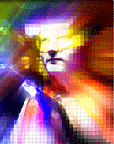
Digital in the Heart of Texas
If you're a fan of video art, live music, or new media performance, Texas is the place to be this week. From April 19-23, The Aurora Picture Show will present their annual Software Cinema festival at venues throughout Houston. The theme of this year's fest is 'Media Archeology,' and it offers a treasure trove of artists, including (in order of appearance) the a/v-jam collective Share, Tommy Becker, Rick Silva, Golan Levin, Sue Costabile, Scott Arford, Tree Wave, Lovid, Yacht, Nate Boyce, My Robot Friend, and Madeline Minx. Billed as a program of 'improvised, interactive, and multimedia performances,' the events will provide introductions to some of the most engaging new media artists practicing in the US. Whether through employment of the super high tech, nostalgically low-tech, or simply everyday materials, each performance will trace the ubiquity of software in our daily lives and in our modes of making and accessing contemporary art. Rhizome's Lauren Cornell and Marisa Olson join artist/producer Nick Hallett as the guest-curators of this year's festival. We look forward to heading south for this lively convergence of innovative and entertaining artists, and to the possibility of meeting a few Rhizome News readers! - Rhizome.org
Posted by jo at 09:58 AM | Comments (0)
Petko Dourmana
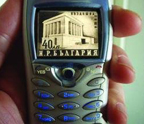
BT_GRAFFITI | Mausoleum_3
The interactive work--by Petko Dourmana--proposes to virtually rebuild the lost physical space of the Mausoleum of Georgi Dimitrov, that used to be the most remarkable public symbol during the Communistic period in Bulgaria, inside the visual and physical space of the entrance at 15 Nassau, New York.
Using Bluetooth technology, visitors are automatically invited to activate it and will receive a series of visual and audio fragments which recreate the space of the former Mausoleum. This newly common-used technology is highly open for communication and in this sense it can be likened to graffiti.
As graffiti in public space confronts passers-by with intentional messages, this work addresses notions of presentation space vs. private space and representations of time and space visually and virtually. [blogged by Emily on Textually]
BT_graffiti project is sponsored by CEC ArtsLink. Produced by InterSpace in association with the Harvestworks Benders and Coders concert series and the 2006 Bent Festival. Presented at 15 Nassau Street in New York City, a venue of the Lower Manhattan Cultural Council. Space donated by Silverstein properties.
Posted by jo at 08:00 AM | Comments (0)
Love City
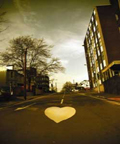
Locative Menage a Trois
Nottingham-based technology artists, Active Ingredient (authors of 'Ere Be Dragons), are to launch an interactive game that will link the people of Leicester, Nottingham and Derby. Love City will allow people to text each other in a game that awards points for making connections with people from the other cities.
The game uses mobile cell location to track users' positions in the three cities. When a player moves between mobile phone 'cells', s/he (Player 1) receives an SMS that includes an update about Love City and the status of other players in their area or in one of the cities. Players can then connect with each other by sending a text to another person in another place. If Player 2 accepts Player 1's message of love, a connection is made and these form a "bonded pair". If a second connection is made from this group to a third player, then a triplet or Ménage à trois is created.
When a triplet is formed, Player 1 is awarded an avatar known as the "offspring" which acts as an agent for them in this particular cell. Subsequent connections with this agent are relayed to the original player who may be far from the cell but can still connect and initiate a process which leads to the creation of more offspring and points for them. Thus their empire grows.
The first test of the game, commissioned by Three Cities, will take place on April 3 – 9 2006.
The full-scale public project is likely to take place at the end of the year when a big-screen projection of the game will be broadcast in the main public spaces of each city.
Via Media Arts Education. [blogged by Regine on Textually]
Posted by jo at 07:47 AM | Comments (0)
Site Specific @ Web

Online art and performance from Italy
Site Specific, a nonprofit organization that promotes site-specific contemporary art on the territory and on web, announces the beginning of its activity hosting inside its web-pages the collective Site Specific @ Web, curated by Corrado Mora with the publication of artworks expressely created for the Internet dimension. All partecipating artists are characterized by different artistic poetries and levels of familiarity with the digital technology, and they all have created works that are able to express their vision of time and space inside the Web, according to their personal experience and sensibility.
The group exhibition will be organized in two different moments linked by a virtual performance that will last almost two months. Site Specific @ Web will present unpublished web/site-specific works by: Riccardo Benassi, Alessandro Capozzo, ConiglioViola, ELASTIC Group of Artistic Research, Casaluce–Geiger [synusi@ virus cyborg], Fausto Gilberti, Laurina Paperina, Chiara Passa, Alex Pinna and Laura Viale.
Saturday 8th April 2006, 6 p.m., works by Riccardo Benassi, Alessandro Capozzo, Fausto Gilberti, Laurina Paperina and Laura Viale will be published on-line. In the same moment it will start Casaluce-Geiger [synusi@ virus cyborg] work in progress, that will last until the date of the Finissage.
Saturday 29th April 2006, 6.p.m., works by ConiglioViola, ELASTIC Group of Artistic Research, Chiara Passa and Alex Pinna will take the place of the precedent works, while Casaluce–Geiger [synusi@ virus cyborg]'s work in progress will continue.
Saturday 20th May 2006, 6 p.m., works of Site Specific @ Web #1 and #2 will be shown together into the Finissage with the conclusion of Casaluce–Geiger [synusi@ virus cyborg]'s work in progress.
On the occasion of Site Specific @ Web it will also announce the winners of the 2006 Edition of IndexPage Competition, the contest promoted by Site Specific and addressed to those artists and designers who were interested in re-elaborating the indexpage of the website.
A Jury composed by Tatiana Bazzichelli (an expert in hacktivism and new media art and founder of the AHA: Activism-Hacking-Artivism project), Mauro Ceolin (a multimedia artist and painter), Corrado Mora (founder of the Site Specific project), Domenico Quaranta (a curator and art critic with a particular knowledge in new media arts) and Valentina Tanni (an art critic, curator, professor, content manager and vice-director of Exibart magazine) has proclaimed as ex aequo winners of the competition'first edition: Hans Bernhard ( ÜBERMORGEN.COM), with the work Psychotropic Drug Karaoke, and MEZ [Mary-Anne Breeze], with the work _ID.Xorcism_.
The artworks' publication will be in contemporary with the Site Specific @ Web # 1 and # 2 and it will be linked by a monographical part about the two artists, curated by the winners and the Jury.
Moreover Site Specific website will be completely redifined according to the concept of Stéphanie Boisset, a french-german webdesigner and artist, that has received the honourable mention of the IndexPage Competition 2006 for her project.
Site Specific
http://www.sitespecific.it/
Posted by luis at 04:44 AM | Comments (0)
April 19, 2006
Infobreath
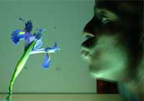
Traffic Sniffer/Visualizer
By breathing on the Infobreath "cybernetic" lilly, people trigger a flurry of text, making visible the wireless internet traffic passing through the air. Rigged with a breath sensor and connected to the Carnivore sniffer, the flower is cued in to the wireless network flowing in the space surrounding it. The plant absorbs and analyzes this information, and releases those packets in a form comprehensible to humans.
A piezo breath sensor registers the breath. The microcontroller attached to the plant converts these signals for the computer and the carnivore client captures network traffic through the computer’s wireless card. 4. the int
Infobreath imagines a world in which the carbon dioxide we exhale carries comprehensible information, and envisions the transfer of carbon dioxide to oxygen within a plant as a transfer of information: an information ecosystem. It imagines the plant, buffeted by streams of wireless data, sifting through those pings and packets for the few elements sent from one human to another, and reflecting those living packets of internet data back to us, in an elemental attempt at communication.
InfoBreath was created by Christopher Robbins, building upon code by Christobal Mendoza, Tom Igoe, and the Radical Software Group. [blogged by Regine on we-make-money-not-art]
Posted by jo at 02:47 PM | Comments (0)
Roch Forowicz's
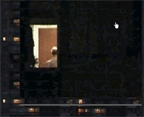
Environment
Environment is a continuation of Roch Forowicz's Invigilate project [Spotlighted on Turbulence in 2005]. It's a networked space in which every member of the project is able to connect with every other member via video, phone and/or e-mail. Environment is open to everyone though Forowicz has specifically invited residents of the apartment complexes surveilled in his Invigilate project.
I hope this space will be much more friendly for them to dialogue. Goal of this action is to create a natural, organic and free from propaganda space of the information exchange.
Environment grew out of Forowicz's perceived "failure" of the earlier project Invigilate--a form of art activity performed in a public space. Invigilate addressed the ever increasing lack of privacy in society, and questioned relationships between people sharing the same space, both social and political. Forowicz recorded people going about their lives in their apartments; he then posted the videos on the Internet and made his email address available to viewers. Forowicz also posted flyers about his activities in each of the apartment complexes; they displayed the Invigilate web site address as well as pictures of the surveilled apartments.
Forowicz's goal was to provoke a dialogue about performed surveillance and the invasion of his subjects' privacy. Unfortunately, nobody responded at first; later he received a few emails from people who didn't understand his actions at all. Forowicz concluded that he needed to encourage people to engage in a dialogue. Environment is the outcome.
Posted by jo at 11:16 AM | Comments (0)
April 1-15th on empyre

Synaesthesia: Amit Pitaru, James Patterson, and Joel Swanson
Synaesthesia is, literally, the convergence of senses. From the Greek roots syn ("union") and aesthesis ("sensation"), synaesthesia describes a phenomena where sound corresponds to colors or tastes. Some people, known as synaesthetes, actually experience this involuntary convergence where touching something gives a taste, hearing something produces a color in the mind, and colors actually create sounds when seen. This is a condition for 1 in 2000 people, so it is not altogether uncommon. Though some have regarded the online experience as breathing new life into the mind/body problem, many artists are already working in a space that engages attention and sense in a convergence across a broader perceptual spectrum.
Three artists anchored the discussion of synaesthetic aspects of on-line experience: Amit Pitaru, James Patterson, their collaborative work at insertsilence.com, and Joel Swanson at hippocrit.com. [Related post]
James Patterson is a visual artist who also works as an illustrator, broadcast & web designer. James' synthesis of drawing, animation and programming has attracted the attention of a variety of galleries and clients worldwide. His work exists online at two primary sites: http://Presstube.com (his personal space) and http://InsertSilence.com (shared with Amit Pitaru). James was born in London, England in 1980 and currently lives in Montreal, Canada.
Amit Pitaru (b.1974) creates new tools to facilitate his work and work in audio-visual arts and interaction/usability design. Pitaru has exhibited and performed concerts worldwide. His personal and collaborative work with James Paterson has recently been shown at the London Design Museum, Institute of Contemporary Arts (ICA), Israel Museum, Paris Pompidou Center, Sundance Film festival, Seoul Metropolitan Museum of Art, and ICC Museum in Tokyo. As an educator, Pitaru develops curricula that focus on the coupling of computation-design and creative thought process. He regularly teaches at New York University's ITP and Cooper Union. Pitaru is a recipient of various prestigious awards, including two Ars Electronica Prix honorary awards and Tokyo Type Directors Club awards. Beyond his artwork, Pitaru is currently working on new gaming interfaces for children with special needs and the elderly. Born in Jerusalem, Pitaru currently resides in New York with his wife Makiko. http://pitaru.com http://insertsilence.com
Joel Swanson is an artist and writer who currently teaches courses on art, technology, and media theory at the ATLAS Institute at the University of Colorado in Boulder. His work consists of articulated reading environments, both real and virtual. Thematically his installations interrogate relationships of power as they relates to space, discourse, language, meaning and subjectivity. He is also interested in the implications of the material specificity of discourse and its effects on both reader and writer. Swanson's work has been shown in various national and international venues. Joel's work is viewable at http://www.hippocrit.com
Also joining us for the first half of April, will be guest moderator Jennifer Gunther [http://auspiciousmotion.org]. Jennifer is a student in the University of Colorado's Digital Media program, and writes for the Anita Borg Institute for Women and Technology.
Posted by jo at 10:54 AM | Comments (0)
eShofar
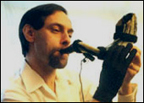
Folk Tradition and Technology
A shofar is a ram's horn used as a musical instrument for religious purposes in Judaism. Mentioned in Hebrew Bible and throughout the Talmud, it is played during high holy days of Rosh Hashanah, the beginning of the repentance period, and Yom Kippur, the atonement. Whilst similar to the sound of a trumpet, the sound produced by the shofar is not strictly musical, it rather provides a call to reflection and an alarm. In the digital era there is who has thought how to modernize the instrument through technology. The idea belongs to Bob Gluck, an American composer, researcher and performer who, using processors, sensors and a custom designed Max/MSP has transformed a simple horn into an eShofar: Electronically expanded, digitally processed ram's horn.
Nowadays there are two versions. The first one, connected to a sensor glove, focuses on finger movements as inputs that create sound. While the second one uses complex algorithms to create a chaotic improvisational system based on the live performed sounds. Gluck's goal consists of encouraging people to cross boundaries between conventional and new musical aesthetics, traditional cultures and modern life, religious and secular sensibilities. Whenever the live performance keeps the ceremonial attitude, listening to the random digital sequence of tekiah (the deep sound) and teruah (the trill), on streaming video is not different from listening to many other electronic experiments. The value remains in the crossover of folk tradition and technology that modernize the past and sparks the creative imagination. Valentina Culatti, NEURAL.
Posted by jo at 10:52 AM | Comments (0)
4'04"
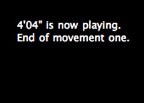
Sound NOT Found
4'04" is a tribute, made by Jon Meyer, to the famous piano musical piece 4'33" written in 1952 by John Cage in three movements. It was like a sonata of four minutes and thirty-three seconds during which no sound is produced intentionally. In this case the author shows us a blank and silent web page for a time range that is shorter than the Cage one. This time length, seen as a pure figure, assumes a very symbolic meaning in the Meyer concept, that relates to the web. In fact it is a simple and elegant joke: 404 is the code of the 'page not found' error, so in a way a 'silent' page. In either case there's a stronger aim than the mere representation of silence.
Cage once went through a new experience, entering an anechoic chamber. There he heard his heart pulsing and his blood flowing, proving that the strict silence doesn't exist. Consequently he turned the traditional concert in a happening when the sounds produced by the bystanders and by the surrounding environment become essential musical elements altogether unpredictable. It's the same aim pursued by Meyer, but, for practical reasons, he's not playing with a collective experience and its consequent emotional impact. He's, instead, referring to a listening invitation and to the daily meditative Zen practice (that was practiced by Cage also), contrasting it beside the non-human rhythms of internet working life. As Cage said: "(...) Art doesn't have to be different from life, but an action inside life. As everything in life, with its accidents and possibilities, and diversity and mess and only momentary beauty (...)". Francesca Colasante, NEURAL.
Posted by jo at 10:46 AM | Comments (0)
Call for Proposals

Tagged: Electronic Tagging and RFID Commissions
Tagged: Electronic Tagging and RFID Commissions [PDF], SPACE Media Arts, London--Deadline for proposals: NEXT WEEK! Friday, April 28, 2005.
SPACE Media Arts invites proposals for a series of four artist commissions that explore creative use and context of electronic tagging technology, in particular RFID. Even if you don’t know what a Radio Frequency Identification (RFID) tag is, you’ve probably used one, whether it’s at your local grocery store checkout, using an Oyster Card, tracking a package you’re waiting to be delivered or in your passport at the airport.
RFID is the barcode of the future. It is a unique identification code that can be tracked through radio waves, sometimes without human contact or knowledge. RFID may help create a real-life internet, where objects can communicate with each other to create complex networks, exchange useful information, and do things for you in every day life. But it could also have a major impact on commercial industry, security and privacy.
In keeping with SPACE Media Arts core objective to engage diversify access to emergent technology, proposals that have a public art focus or that show an understanding of the communities in which they will be presented are particularly encouraged.
The production budget/ artist fee for each commission is £3,250. Production should be completed by October 2006, and projects are expected to be presented to the public. Commissioned artists will also be offered the opportunity to be involved in Who Designs the Future?, a one day workshop and presentation at the HCI 2006 ENGAGE conference at Queen Mary University London in September 2006.
When evaluating proposals, the panel will consider artistic merit, technical feasibility and audience/participant awareness. Although we will provide some project mentorship and technical advice, artists must show in their proposals that they can execute their own projects.
Artists will be notified of the status of their proposal by Friday, May 12.
***How to Submit a Proposal***
A proposal must include:
1. A project description of 1000 words maximum. This should describe what the project is, its main concepts and how it will be realized. 2. You are encouraged to include a production timeline and a project budget, which should include your artist’s fee. 3. Your individual or collective CV. If you plan to work with a technical assistant or collaborators, their information should be included. 4. A completed application form, available at http://www.spacemedia.org.uk
Questions can be directed to Heather Corcoran at heather[at]spacestudios.org.uk.
Posted by jo at 10:45 AM | Comments (0)
The Empire's New Clothes

Art, Fashion and Technology
The Empire's New Clothes - Art, Fashion and Technology workshop by Sabine Seymour & Erich Berger: Wednesday 10th of May - Saturday 13th of May at Atelier Nord Oslo/Norway. Free participation; Application deadline monday 24th of April; Send applications with CV to sense[at]anart.no
During the workshop the following topics will be adressed: * Introduction into fashion and wearables in art and design * Applicable fashion theory * Textiles, new materials and technology * Physical computing for fashion and wearables (sensors, wireless communication, etc.) * How to design * Concept development * Hands on experiments and presentations.
Clothing was among the first cultural and technological achievements of the human. Since its first intention as a second skin, communication technologies and smart materials dramatically changed its use. Clothing itself became an interface to the digital space which surrounds us. The workshop will show how textiles and technology appear in artistic practices and will introduce materials and techniques in use and in research. Participants will work and experiment on an expanded idea of fashion and technology.
Especially participants who already attended the previous workshops will be able to apply their ideas and skills on the very fabric of society.
WORKSHOP PARTICIPATION
Participation is free of charge.
Artists, designers and practitioners interested in participating are asked to apply with a CV to sense[at]anart.no
Application deadline monday April 24th.
Workshop directors and producer:
Sabine Seymour (AT/USA) http://moondial.com
Erich Berger(AT/FI) http://randomseed.org
The empires new clothes is part of the Interface and Society project at Atelier Nord, http://anart.no/projects/interface-and-society/. Upcoming workshops at Atelier Nord:
June : Media art and public space with Susanne Jaschko (DE)
September: Mobile media art with Laura Beloff (FI)
ATELIER NORD
PHONE +47 23060880
FAX +47 23060884
E-MAIL office@anart.no
URL http://anart.no
MAIL Lakkegata 55 D, N-0187 Oslo, Norway
Posted by jo at 10:33 AM | Comments (0)
Attention Please!
![]()
An Attention Seeking Video Installation
Artist Sara Smith and technology partner Kisky Netmedia are creating Attention Please! An Experiment - attention seeking video designed to measure attention.
Is it possible to measure our impact on space and on art? The attention Please! experiment attempts to answer this question using RFID (Radio Frequency Identification) technology. Audience members, visitors, participants, and collaborators pay attention with their an Attention Card to a piece of video. If you pay more attention, does it work harder to keep it? Other videos may feel neglected and try to attract your attention away; your attention is valuable after all.
Its focus is on manipulating the relationships between art, technology and audience, within and outside of a gallery environment. The concept centres on Sara's aim to explore the notion of presence, aura, and attention and uses emerging and everyday technologies to reveal some of these subliminal and emotional notions.
We live in a world where many services, products and people are continually competing for our attention. Each day our attention is attracted and divided; what to wear, where to eat lunch, where and how to party the night away. We are faced with images, stories, emotions all around us, on billboards, radios, and TV screens. Can our attention be turned within a gallery? What happens if we pay attention to some art more than other art? Will it know? Does it matter? It does now!
The experiment asks nothing more than for you, the audience to give your attention. Pay attention at The Box, FACT, 88 Wood Street, Liverpool, L1 4DQ. 03 & 04 May 2pm - 6pm.
Attention Please! An Experiment is a research project supported through ITEM, the Foundation for Art and Creative Technology¹s research and development programme for new media tools. ITEM is supported by NESTA and Arts Council England.
Posted by jo at 10:24 AM | Comments (0)
April 18, 2006
Ken Goldberg's Ballet Mori

A Ballet Conducted by the Earth
To commemorate the 1906 San Francisco Earthquake, Ken Goldberg conceived Ballet Mori to engage the Earth as a living medium and a conductor for dance. For the first time, network technology was combined with ballet to directly link the natural world to classical performance.
In this improvisational performance, SF Ballet Principal Dancer Muriel Maffre responded to a musical composition modulated live by the unpredictable fluctuations of the Earth's movement as measured in real time by a UC Berkeley seismometer at the Hayward Fault. [Wired article]
"April 18 is the 100-year anniversary of San Francisco's Great Earthquake. How can we understand sounds far too sublime to be perceived by the human ear?
This question was brought to the fore by a team of American media artists led by UC Berkeley's Ken Goldberg in "Ballet Mori," performed at the San Francisco Opera House April 4 to commemorate the 1906 Earthquake. Muriel Maffre, a principal dancer of the SF Ballet, danced to sound activated directly by the movements of the earth. Seismic data from the Hayward fault was transmitted to the opera house via the Internet and transformed into a soundscape by composer Randall Packer using Max/MSP. All in real time. The performance brought to mind Walter Benjamin's concept of the "optical unconscious." Just as the technology of photography makes it possible to see things normally invisible to the naked eye, Ballet Mori's networked sound system facilitates a meditation on the "acoustic unconscious." It allows the audience to hear the sound of the earth, which cannot be heard with the naked ear. The result was a suggestive and very beautiful synaesthetic experience that challenged the classical ballet audience and ordinary patterns of hearing. Video clips are online at: http://goldberg.berkeley.edu/art/Ballet-Mori/"--Ballet Mori and the Acoustic Unconscious by Anna Orrghen.
Anna Orrghen is a PhD Candidate in Media and Communication Studies at Stockholm University. She is currently finishing her dissertation, which explores the process by which a new medium emerges, with special attention to the discourses of art and Swedish mass media at the turn of the 21st century. She also works as a cultural critic in Sweden. e-mail: anna.orrghen[at]sh.se
Posted by jo at 05:26 PM | Comments (0)
UPGRADE! MONTREAL
![]()
! .... TACTICAL MEDIA ........ !
It's spring, dammit, and Upgrade! Montreal is making no exception by bringing in some novelty this month. It is one of the first times that Upgrade will take place outside the SAT (Society for Arts and Technology), that is, at UQAM's Hexagram's lab (209 Ste-Catherine E) in order to diversify its audience and partners (note: Upgrade May will take place again at SAT). Moreover, the April format is slightly different, taking the form of a good ol¹ show-and-tell, in the view of demystifying the practices and the tools of tactical media.
April features tactical media and tactical art, where practitioners work in-between art and politics in order to momentarily occupy and infiltrate structures of mass media & culture. The evening aims to expose (and make accessible) diverse practices by posing the question of a tactical media culture in Montréal.
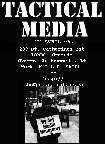
For the occasion, Danny Perreault will remind us of fragments of certain ideas of Dutch theorist Geert Lovink, while also showing how to control appliances at distance. Dominic Gagnon will show some of the achievements of the transnational collective At Work, which aims to transform creatively the workspace into resistance to neoliberalism. As for Stéphanie Brodeur and Darsha Hewitt, they will give us a demonstration of Magnetic Identity Liberation Front (M.I.L.F.) and GridFlow, whereas Robin Millette will talk about practices of hackers linked to groups and organizations like Cogitateurs-Agitateurs and FACIL. The show-and-tell will be followed by a roundtable discussion moderated by tobias c. van Veen, a scholar of interventionist media as well as tactical media practitioner himself.
The March Upgrade is free, bilingual and open to all. Doors open at 6.30 pm the show-and-tell promptly begins at 7pm and it¹s all free kids!
- Sophie, Anik & tobias
---French version---
Avril 27 Upgrade:
! .... TACTICAL MEDIA ........ !
Une culture de médias tactiques à Montréal?
Un show-and-tell sur les médias et l¹art tactiques
--
Wot? Tactical media culture in Montreal?
A show-and-tell on tactical media & tactical art
====================
:: LOCATION ::
Hexagram - UQAM 209 Ste-Catherine E.
=== HORAIRE ===
€ 18h30: doors open/ouverture des portes
€ 19h00: show and tell
Danny Perreault (Skerzo, etc.)
Dominic Gagnon (Au travail / At Work)
Stéphanie Brodeur & Darsha Hewitt (Magnetic Identity Liberation Front) Robin Millette (Cogitateurs-Agitateurs, FACIL, etc.)
€ 20h00: discussion table-ronde / roundtable
moderée par / moderated by tobias c. van Veen
€ 21h00: Fin
==||==
: : UPGRADE! : AVRIL: :
C'est le printemps asti, et Upgrade ne fait pas exception en amenant du nouveau ce mois-ci. C'est l'une des premières fois qu¹une soirée Upgrade aura lieu hors les murs de la SAT (Société des arts technologiques), soit au laboratoire d¹Hexagram de l'UQAM (209 Ste-Catherine E) pour ainsi diversifier son public et ses partenaires (note : nous serons de retour à la SAT en mai). De surplus, la formule d'avril est quelque peu modifiée avec au menu un bon vieux « show-and-tell », question de démystifier les pratiques et les outils utilisés ou déployés pour un public actif. Avril s¹intéresse à la question des médias et de l'art tactiques, cette pratique qui se situe entre art et politique pour occuper et infiltrer momentanément les structures des médias et de la culture de masse. La soirée vise à exposer (et rendre accessible) diverses pratiques en posant la question d'une culture de médias et d'art tactiques à Montréal. Pour l'occasion, Danny Perreault nous fera part de fragments d'idées du théoricien Geert Lovink, tout en nous montrant aussi comment contrôler des électroménagers à distance. Dominic Gagnon nous montrera les accomplissements du collectif transnational Au travail, qui vise à transformer de manière créative le lieu de travail en une résistance au néo-libéralisme. Quant à elles, Stéphanie Brodeur et Darsha Hewitt nous ferons une démonstration de Magnetic Identity Liberation Front (M.I.L.F.) et de GridFlow, alors que Robin Millette nous parlera des pratiques de hackers liées au groupe Cogitateurs-Agitateurs et à l'organisme FACIL (pour l'appropriation collective de l¹informatique libre). Le « show-and-tell » est suivi d¹une discussion table-ronde modérée par tobias c. van Veen, tacticien lui-même.
L¹événement est bilingue et ouvert à tous et toutes. Les portes ouvrent à 18h30 le « show-and-tell » débute promptement à 19h00 et c¹est gratuit les enfants!
Posted by jo at 01:15 PM | Comments (0)
Upgrade! Amsterdam
![]()
going live tomorrow!
Upgrade! Amsterdam 0.0: THOU SHALT NOT UPGRADE! going live tomorrow:
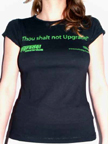
When: April 19 2006, 20.30 hours; Where: De Melkweg, Theaterzaal, Lijnbaansgracht 234 A, Amsterdam; | free admission | | cocktails | | T-shirts |
THOU SHALT NOT UPGRADE! | GIJ ZULT NIET UPGRADEN! | Met “upgrade” wordt meestal technologische verbetering, vooruitgang en ontwikkeling bedoeld: alles moet sneller, beter, kleiner. Maar de technologische geschiedenis is ook één van keuzes die bepaald worden door contextuele factoren. Wat laten we achterwege in onze huidige obsessie met upgraden en wat winnen we? Wat zijn de bredere culturele implicaties van het begrip “upgrade” in onze informatiesamenleving. Wat betekent het voor de kunsten, design en hoe we de wereld ervaren? Zijn er heilige huisjes waar we niet aan mogen komen: Gij zult niet upgraden?
Gasten:
| Max Bruinsma | Onafhankelijk design- en kunstcriticus, curator, editorial designer. http://www.maxbruinsma.nl/
| Taco Stolk | Conceptueel kunstenaar and hoofd van de ExtraFaculteit (xFac) van de Koninklijke Academie van Beeldende Kunsten, Den Haag.
http://www.wlfr.nl/
Performance interventie door:
| Aart Muis | en zijn | BrainClone | http://www.aartcore.com
Posted by jo at 12:59 PM | Comments (0)
UPGRADE! SALVADOR
![]()
:) *Smile, you are in bahia* :)
Upgrade! is an international, emerging network of autonomous nodes united by art, technology, and a commitment to bridging cultural divides. Its decentralized, non-hierarchical structure ensures that Upgrade! (i) operates according to local interests and their available resources; and (ii) reflects current creative engagement with cutting edge technologies. While individual nodes present new media projects, engage in informal critique, and foster dialogue and collaboration between individual artists, Upgrade! International functions as an online, global network that gathers annually in different cities to meet one another, showcase local art, and work on the agenda for the following year.
On the first brazilian version, Upgrade! Salvador creativity invested on movement's propositions. A city's perception and the artistic movements that uses it as a stage for their performances, presenting these movements to the classic medium, the common citizen. [and let the art presents it my -his/her- self spaces!], creating new possibilities of expansion of each localized action. Upgrade! re-cognize-knowledge to artistic re-existence.
MAY 01: WORKER'S DAY - Get you arse down there and work! WHEN, WHERE 9h00 @ the bus stop on largo da vitoria
Upgrade! Salvador: a GATHERing to celebrate the di ver see ty of the meeting -
artistic experiences of social intervention and the recognition of actions.
__________________________
:) *Sorria, voce esta na bahia!* :) http://www.midiatatica.org/upgrade
Upgrade! é uma rede emergente internacional de núcleos autônomos unidos pela arte, tecnologia e o compromisso com o multi-culturalismo. Sua estrutura não-hierárquica e descentralizada garante que o Upgrade! (1) funcione de acordo com interesses locais e seus recursos disponíveis; e (2) reflete o atual engajamento criativo com tecnologias e artistas de ponta.
Em sua primeira edicao nacional, Upgrade! criatividade investida na proposicao de movimentos. a percepcao da cidade e dos movimentos artisticos que a utilizam como palco de suas performances. apresentando esses movimentos ao meio classico, ao cidadao comum [e que a arte se apresente eu seus - dele - espacos!], criando novas possibilidades de expansao de cada acao localizada. Upgrade! re-conhecimento para re-existencia artistica.
01 DE MAIO: DIA DO TRABALHO - De as caras e venha trabalhar!
QUANDO e ONDE
9hs00 @ ponto de onibus do largo da vitoria
=-=-=-=-=-=-=-=-=-=-=-=-=-=-=
REUNA-SE para celebrar a
di ver cidade do encontro -
experiencias artisticas de
intervencao social
e reconhecimento das acoes
=-=-=-=-=-=-=-=-=-=-=-=-=-=-=
Posted by jo at 12:51 PM | Comments (0)
Digital Art and New Media
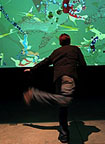
EXPERIENCE ART AT ITS INTERSECTION WITH TECHNOLOGY
UCSC's Digital Art and New Media (DANM) MFA Program and Porter College in association with the Santa Cruz Museum of Art & History @ The McPherson Center, The Santa Cruz Film Festival and the Digital Media Factory present a series of exhibitions, performances, films and symposia:
• Renowned media artists Jim Campbell, Paul DeMarinis and Camille Utterback exhibit and speak downtown at the MAH
• Cutting-edge algorithmic and new music demonstrations and recitals including performances from John Bischoff, Sue Costabile and Leatitia Sonami
• Historical and contemporary film presentation of works by John Whitney, Woody and Steina Vasulka, Jennifer Montgomery and Harun Farocki
• Stimulating symposia with top researchers in music and sound practice, performing arts and biotechnology
• Works by faculty and graduating students of UCSC's Digital Arts and New Media MFA program presentation.
Choose from a large selection of events to experience the latest ideas buzzing through the world of digital and new media art. Art and technology will take over Santa Cruz when the new DIGITAL ARTS AND NEW MEDIA FESTIVAL kicks off in early May, with some events continuing into June.
This presentation of exhibitions and symposia contributes to the art culture in Santa Cruz by showcasing and developing the latest work in digital art and new media.
Contact Elena Lledo at elledo[at]ucsc.edu for more information.
Felicia Rice, Program Manager, Digital Arts and New Media MFA Program
Porter D-121, UC Santa Cruz
Phone: (831) 459-1554
Fax: (831) 459-3535
Email: fsrice[at]ucsc.edu
Posted by jo at 11:56 AM | Comments (0)
2006 Dance Research Society, Taiwan [DRST] ANNUAL CONFERENCE

Dancing under the Rising Sun: Call for Papers
[Submitted by Yukihiko YOSHIDA] 2006 Dance Research Society, Taiwan [DRST] ANNUAL CONFERENCE: Dancing under the Rising Sun: The Influences of Japanese Colonialism on Dance in the Asia-Pacific Region; 8 - 10 December 2006, Taipei National University of the Arts.
What did the Japanese colonialism bring to the colonized countries in the Asia-Pacific region before the end of the Second World War? Political hegemony or modernization? Uprooted traditions or transplanted new cultures? How has this legacy of colonialism molded the dance scene in contemporary situations in various Asian countries?
As a result of the search for national identity in the postcolonial era, Taiwan's reflections on the Japanese colonial influences have continuously motivated the academic to examine the ideological and practical impacts that have intertwined with or even dominated peoples' daily lives in many aspects and on different levels. In the area of dance in particular, Japan once served as the channel for the 'new dance' formulated in Europe and America; moreover, the Japanese regime nurtured the first generation of contemporary choreographers and dance educators in Taiwan. In recent years, studies focused on this period have begun to accumulate and gained attention among the academics and dance practitioners alike.
Though many Asia-Pacific countries shared the common past of Japanese occupation before 1945, their colonial experiences were hardly a unified one. Different cultural schemes and historical courses contributed to the complexity of regional developments. This conference is the first attempt to gather, compare, exchange, and reflect on the experiences of different countries and geographic areas. Diverse and even contrasting interpretations of the influences of Japanese colonialism are expected, and will surely broaden our understanding of how human beings connect themselves to history, culture and society through dance. Dance practitioners, scholars and historians, as well as researchers in culture studies and other related social sciences, are welcome to participate in and contribute to this dialogue. The conference's themes include:
1. Colonial modernity: influences of Japanese colonialism on various dance practices and their relations to the social process blending colonization and modernization.
2. Cultural hegemony and aesthetics: the influence of Japanese hegemonic ideology on aesthetic conception which modified or formulated new genres, styles and categories of dance.
3. Gender, class and national identity: the strategic production of dances as the reflections of the newly-formed social stratification under colonialism
4. Other related topics.
The official languages of the conference are Chinese and English. Proposals
of the following forms are welcome:
1. research papers
2. theme panels
3. video/image presentations
Those who are interested in presenting should submit an abstract no more than 500 words in Chinese or English before 1 April 2006. The abstracts will be reviewed anonymously by the conference committee, and the result will be announced by 15 May 2006. Please fill in the attached form of submission, and send it along with the abstract by E-mail to Ya-ping Chen, PhD at ypchen@[at]nce.tnua.edu.tw. An e-mail receipt will be sent to the applicant as the confirmation of submission.
Conference Committee:
Dance Research Society, Taiwan (DRST)
Graduate School of Dance Theory, Taipei National University of the Arts # 1,
Hsueh-yuan Rd., Peitou, Taipei 112, TAIWAN
Submission Form
Family Name: First Name:
Nationality:
Affiliation/Institution and Position:
Contact e-mail address:
Contact phone number:
Contact postal address:
Title of paper/theme panel/video or image production
Equipment needed:
Posted by jo at 11:43 AM | Comments (0)
RFID & the Internet of Things

Workshop 9 | 10 | 11 May @ Mediamatic
RFID & the Internet of Things Workshop 9 | 10 | 11 May @ Mediamatic: RFID will play a pivotal role in fusing the physical world with the digital. RFID allows for the unique identification of objects, and any kind of online data can be linked to these unique ID's. Here is where the real world and the Internet become two faces of the same reality. What are useful things to have online? How can the sharing of information between things yield us new meanings and experiences? What are important kinds of human agency that should be designed into an Internet of Things?
The participants of this workshop will develop critical, utopian or nightmarish scenarios for an Internet of things. Ideas can range from scripts for small new rituals to outlines of societal changes of epic scale.
The morning sessions are dedicated to lectures on current technology, theory and implementations of RFID. In the afternoons participants will develop their projects. Participants can use the workshop tool consisting of RFID tags, readers and an online database. Experienced staff will be present for technical assistance. The workshop ends with an informal presentation.
PRACTICAL
The workshop has room for 16 designers, artists, thinkers and makers who are interested in this technology and its possible effects. Participation fee is €350 per person, ex BTW. Lunches, technical equipment and assistance are included.
The workshop will take place in the seminar room of Mediamatic, at the 5th floor of the Post CS building, Amsterdam, The Netherlands.
If you want to participate in this workshop, please register at our online registration form.
The reader for this workshop can be found here.
For questions or more information, surf to http://www.mediamatic.net/artefact-11183-en.html, mail to workshops@mediamatic.nl, or call Klaas Kuitenbrouwer: +31 20 6389901.
Posted by jo at 11:29 AM | Comments (0)
April 16, 2006
¢apital magneti¢

Social Music Composition with Credit Cards
Each magnetic card, like its owner, is unique. ¢apital magneti¢, by Mark Trayle, is a network-based installation that explores the musical possibilities of the credit card. Participants can use their credit cards and bank cards to compose pieces of music in cooperation (or competition) with other participants. Special ATM machines are used to read the card: they contain a PC, a monitor, a credit-card reader and two speakers.
Each time a card is swiped the contents of its magnetic stripe are captured and parsed to form the melodic motifs of a short musical composition. Using genetic algorithms, compositions compete in a simulated music marketplace. Some become dominant, others less 'popular'. Some combine to form new 'styles' or 'genres' that in turn influence the more popular ones, etc.
Trayle will be on Friday April 7th 8pm at Machine Project in Los Angeles, to read your credit card data and turn it into music.
From Musical Credit Cards on we make money not art.
Posted by jesse at 10:52 PM | Comments (0)
Sharer! The community object sharing service
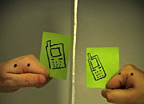
Design Project Promoting Shared Objects
Our project researches into interpersonal limitations and possibilities of sharing of objects. What types of objects people are willing to share. Which with social circles are people willing to share with. How peoples relationships change with objects when the history of the object changes, that is will people feel uncomfortable when they do not know how the object is used when they are not around it.
Read more about Sharer on Vinay Venkatraman's web site, or on we make money not art.
We started our investigation by studying existing recycling systems, The "Kabadiwalla" or junk man in India, the "Garage Sale" system in the U.S and the Storage space concept in some urban scenarios.
In the process we conducted user studies under simulated conditions, Ran a mockup service, resolved logistical issues, Prepared a business Plan and revenue model and worked on several touch points and the interactions involved in the same.
The systems seeks to develop an collaborative object sharing system, users can upload pictures, give description and browser other people object through a website. The system works in collaboration with the postal system and the postman is the point of contact to the lender. A series of secure electronic lockers are the transit point for the object and the borrower picks up the object and deposits it back there after the loan period is up.
Each module of the service works within a postal code to build better trust and simplify logistics. But the service by itself is scalable to any geographic size and object volume.
From Vinay Venkatraman's web site.
Posted by jesse at 09:41 PM | Comments (0)
April 13, 2006
Mobilefest 2006 Symposium
![]()
Call for papers and projects
MOBILEFEST is the First International Festival of Mobile Art and Creativity, and will take place in September, in São Paulo, Brazil. In its first edition, it aims to discuss the sociological, cultural and esthetics implications that mobile phones and their technologies have been promoting globally. In fact, the global transformations the world has been gone through have modified the way we realize, interpret and represent reality.
Nowadays the great majority of people worldwide make use of numerous mobile devices, and artists, engineers, technologists and civil society propose new applications daily for the use of this recent technology. Therefore, within this context comes MOBILEFEST - International Festival of Mobile Art and Creativity, a Brazilian project that consists of the realization of an international symposium, awarding of the best national works that involve mobile technology and educational workshops.
MOBILEFEST 2006 seeks paper and presentation proposals responding to the Symposium themes:
How can Mobile Technology contribute to democracy, culture, art, ecology, peace, education, health and third-sector?
SUBMISSION PROCEDURE FOR OPEN CALLS:
Submissions should be sent by February 28th 2006 via email to
papers@mobilefest.org
Complete name:
Age:
Country:
City:
Telephone number:
Mobile number:
University (optional):
University level (optional):
Proposed category (democracy, culture, art, ecology, peace, education, health and third-sector):
Papers submitted are limited to 30 minutes.
Paper presenters will be grouped thematically according to the proposed category.
Submissions should include a brief description of the proposed presentation (up to 200 words) inclusive work and participants along with appropriate documentation. (rtf, doc or pdf)
Send your submission to: papers@mobilefest.org
All selected presentations will be Webcast live and also available as podcasts immediately following presentation.
DEADLINES - IMPORTANT DATES:
Submission of proposal abstracts: May 11th, 2006
Notification: June 1th, 2006
For help or questions: festival@mobilefest.org
Posted by luis at 08:46 PM | Comments (0)
Extrapolations
![aveofartists[1].jpg](http://www.turbulence.org/blog/archives/aveofartists[1].jpg)
Call for projects
Wigged Productions in collaboration with curator Humberto Ramirez is seeking Web-based artists working in video, animation and netart to contribute projects for an online exhibition addressing the concept of "EXTRAPOLATIONS" We are particularly interested in works situated outside of mainstream visual strategies, using anachronism, simulacra, radical denial, historical revision, nonlinear narratives, humor etc. The idea of critique as an oblique activity, tangential and tactical is central to this project.
In order to submit your work for consideration, please provide your name, title of project, short synopsis and URL address by email to extrapolations[at]hotmail.com, or alternatively send DVD with QuickTime movie or miniDV by May 25, 2006 with requested information to:
EXTRAPOLATIONS
P.O BOX 1637
BRATTLEBORO, VT 05302-1637
The online exhibition will run from July 1, 2006 through June 15, 2007 and the deadline for submissions is May 20, 2006.
Posted by luis at 08:15 PM | Comments (0)
April 12, 2006
experimental geography
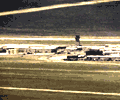
how to interpret the world around us
The work of Trevor Paglen is tactical media, speculative non-fiction - an "experimental geography" - as he calls it, accompanied, of course by "experimental lectures". The online component of his work has a travel-logue quality, with interventions and alien inspired expeditions validated by documented, journalistic interviews. Paglen is a cross-disciplinary practitioner and tactitioner in writing, installation, photography, lectures, performances, interventions, and exhibitions. He appropriates technologies and practices and originates the necessary techniques. One such, "limit-telephotography", was developed for The Secret Bases project to examine the non-space of secret bases and their supposed non-existence.
In projects like Carceral Landscape the Prison Infiltration and Surveillance Suit was performance attire developed to enable covert videography for the project. Documentation is shown from these visits. Pagen co-opts the stealth technlogies to spy back on the spies and uncover the covert, which he weaves together in speculative, but plausible narratives to help us interpret the world around us.
Posted by michelle at 04:54 AM | Comments (0)
April 09, 2006
live broadband tv

Exploding Television
Exploding Television is a live internet broadcast during Rotterdam Film Festival. Talks, Workshops, documentation of the Exhibition, and Artist Works can be seen in the archive.
See the streaming video of the DIY_tv session focusing on the growing phenomenon of independent microTV broadcasters.
The Italian microTV movement, Telestreet, started as a loose group of TV micro-broadcasters that first went to air in Italy in 2002 in a neighborhood station based in Bologna. These loosely affiliated broadcasters share an enthusiasm for exploring the socializing power of free-to-air video (TV) broadcasting. Often their content is sourced from the independent content archives such as V2V and the Italian viral video distribution project NGV. However, in the words of their manifesto, "Television must be considered a new prosthesis and an extension of the net [...] the horizontally of the net must meet the 'socializing' power of television."
In the words of David Garcia "[Telestreet] are squatting the shadows or blank spots which terrestrial broadcasters cannot reach." They not only make their own content, but also their own transmitters and antenna. Dedicated to the socializing power of broadcast television, the project has provided an important inspiration for many Italian media activists, and has fueled a movement dedicated to the development of critical approaches to localized production and distribution of TV.
Posted by michelle at 02:26 AM | Comments (0)
open, participatory platforms for audiovisual production

multi channel internet tv
mcult was established in 2000 to support production, research and development of new media culture by an active involvement in the practices, policies and structures of the field. Aiming at a sustainable development of media culture, m-cult works to create productive and critical, interdisciplinary encounters between actors in culture, technology and society.
m-cult focuses on social and cultural innovations in urban, wireless and participatory media, and on developing open infrastructures and transdisciplinary competences in new media culture. m-cult carries out research projects, consults on media culture and technology development, disseminates information and organises events in media research, arts and technology.
m-cult's project to establish a lab for urban media now has a concrete target. The plan is to launch a collaborative production environment at Kansatalo ('People's house', named after an extinct insurance company) located in Kurvi, Eastern Helsinki. The Kurvi space is aimed to support production of urban and media culture and to house a continuous series of workshops, seminars and debates. Negotiations about the project are now in their final phase, and results are expected in May 2006.
Posted by michelle at 02:25 AM | Comments (0)
Sankari Show
live talk karaoke

Sankari is an improv show offering people a fun way to perform in front of an audience. It is a combination of karaoke, drama and video game. It's a participatory interactive video show about Elias. Elias is quite a nice guy, but he is not able to speak. So he is a little bit helpless on his own. Actually, Elias is speaking, but we have taken away his voice. That is the genius of the show. People from the audience have to give Elias their own voice. What they say defines his future.
“Sankari” is the Finnish word for a hero. It also means the main character in a story. The format is based on interactive scenes where the participant improvises with virtual characters. The scenes consist of small video fragments. We listen to the improvisation and choose how other characters react by showing different video clips. The story can develop in many directions depending on the performance. A step-by-step guide.
Posted by michelle at 01:25 AM | Comments (0)
ambienttv.net
transmedia practice
ambienttv.net is a crucible for independent, interdisciplinary practice ranging from installation and performance, through documentary, dance, and gastronomy, to sound and video composition and real-time manipulation. We continue to develop social and technical infrastructure and promote network architectures that facilitate alternatives to current socio-political and economic formations. Techniques and effects of live data broadcasting and transmission provide theme, medium, and performative space for many of the works.
ambient.tv describe networked performances as linking geographically distant real spaces with networking technologies such as live streaming. Themes and narratives grow out of telematic feedback, and the interplay between real spaces and imaginary realms. ambientTV.NET's networked performances span the range from dance-theatre to poetry-gastronomy.
 AV DINNERS 1: EPIC EROSM is a live and online audio-visual gastronomic event. The first in a series of sensory networked cook-ins featuring collaborations between digital and performance artists and chefs.
AV DINNERS 1: EPIC EROSM is a live and online audio-visual gastronomic event. The first in a series of sensory networked cook-ins featuring collaborations between digital and performance artists and chefs.
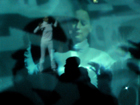 TELEJAM: MYRIORAMA is a telematic dance performance using GPS and sensor systems in collaboration with kondition pluriel. Texts written by roaming performers are tagged with location data and projected into a surround-audiovisual environment.
TELEJAM: MYRIORAMA is a telematic dance performance using GPS and sensor systems in collaboration with kondition pluriel. Texts written by roaming performers are tagged with location data and projected into a surround-audiovisual environment.
 tryptichon is a dance / sound / video performance within a live locative media environment.See video
tryptichon is a dance / sound / video performance within a live locative media environment.See video
CCTV filmmaking as performance or THE FILMMAKER AS SYMBIONT is a manifesto for the opportunistic infections of the surveillance apparatus.
Arist Manu writes on wearable computing, artistic possibilities in a broadband environment and other issues of networked existence.
Posted by michelle at 12:20 AM | Comments (0)
April 08, 2006
MARSVILLE.tv

distributed lightpath performance
Michael Bussiere's project, MARSVILLE.tv is a "television channel" inhabitingCanada's Ca*net4 - the world's first national optical Internet research and education network. Marsville.tv blends video conferencing, live programming and the original television stage to propose a new form of spatially distributed, participatory performing art.
In its most ambitious conception, Marsville.tv seeks to establish a permanent home on CA*net4, a multi-media research/performance channel programmed to inform next-generation, i-TV content and production. This ongoing project investigates the creation and rendering of experimental multi-media over high-speed networks, with particular emphasis on live, interactive performing art forms. It seeks to provoke new social dynamics within a distributed performance environment, and to investigate technical prototypes and the creative possibilities of embedding cyberspace into multiple performance venues.
Marsville.tv begins from the premise that musical communication is spatial in nature and therefore offers an appropriate content source for the exploration of near-instantaneous distributed expression. The project's initial content is informed by an historical repertoire designed almost in precognition of distributed performance space as a context. It embraces the creative possibilities and the paradox of dwelling in separated spaces while sharing a common virtual space. Composer John Cage's intention, for example, to avoid the perception of sounds as finite temporal objects was linked to a solution that entailed the underscoring of sounds as spatial objects. For Cage, the spatialization of sounds offered a means of fracturing a seemingly natural tendency toward temporal organization and logic. Add to this Cage's mandate for the superimposition and simultaneous performance of different works (for the intensification of the feeling of space) and one discovers a prototype for a new broadband-based repertoire. Cage's proposal that indeterminacy transforms roles (the performer becoming the composer, the audience becoming the performance, and the composer becoming a member of the audience) anticipates a performance scenario where spatially distributed performance requires new means of audience engagement.
MARSVILLE.TV also turns to, among others, repertoire of a different sort, that of television pioneer Ernie Kovacs.
Kovacs was all over US network television between 1950 and 1962. After an early career on stage and radio, Kovacs entered the world of television with a new vision of the medium's creative idiom. Working with engineers and scientists, kovacs used broadcast video to break the confines of the stage and camera, and created a new video signal-based proscenium. What could be dubbed special effects were indeed radical insights into the unique attributes of an unconventional televised spatial physics. More remarkable perhaps is the fact that Kovacs utilized comedy and music theatre as a vehicle for reaching a newly emerging mass audience, an audience that was mesmerized by the new medium's luminosity, and its capacity for stretching the optic nerves of its inhabitants into myriad spatial realms.
Network latency is just one issue that characterizes the experience of live broadband content. It may one day be reduced to the point of inconsequence with respect to traditional performance repertoire. On the other hand, current capabilities provoke questions. Can music incorporate latency as a fundamental design challenge? Is there an historical repertoire that was written almost in precognition of latency as a context? Does this repertoire anticipate a new network-based musical idiom? What is the performance proscenium and repertoire of broadband cyberspace?
Marsville.tv seeks this new emerging repertoire.
What is the proscenium of multi-point virtual space, and what
are the musical and performance theories that emerge from it? full A href="http://marsville.tv/videos/documents/Zen,%20Cage.pdf">pdf
Posted by michelle at 11:05 PM | Comments (0)
Platial

Personal Geography as Social Atlas
Platial is a google mashup where you create a personal geography by annotating a google map while building a collabroative atlas. Called 'auto-geo-biography' because the traditional views of place don't represent our relationship to them. Although a commercial site that may become mired in averstisement, it mixes social/psycho geography and locative media driven by storytelling and community building.
According to cnet, the service is part of an increasingly popular Net practice of taking otherwise static data, mixing it with another service, and creating new applications, commonly referred to as mashups. Sometimes, even a spontaneous community forms around it. Housing maps.com, for example, combines Google Maps and local real estate listings from Craigslist.
Posted by michelle at 10:12 PM | Comments (0)
NABI : Korean New Media Art
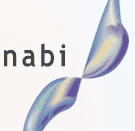
Site now in English
Art Center Nabi is now available in English. In the Performance section see the residency project 'Movable Type and Instant Spaces' on the theme of urbanity and new media. It will be exhibited at ISEA in San Jose in August.
Artist Tae-Yoon Cho and team Jangseung project is based on research of nomadic structures in urban spaces creatign temporary, stie-specific drawn from vernacular embodied through local architecture and cultural such as vendors, tents, advertisements, as a manifestation of human perception of local space.
Also check out earlier nabi project Liquid Space
The art production of the project revolves around three person collaboration, the team Jangseung. The project is founded upon rigorous planning, collective brainstorming and writing about each artist's position to the movable type architectures and instant spaces it creates. The final presentation at the ISEA 2006 container culture show is one of the example in this process. The project utilizes the container as a headquarter 'platform' to investigate temporary urban spaces in San Jose.
Structures are remodeled so to be wearable for a human to walk around in it. It is poetic and reminiscient to vaudeville shows costume. It is not a modular architecture in a sense that it repetitive programs of structure that builds up on itself. but it shares some aspect of modular architecture, each of these wearable architectures are related to each other in a semantic way. Each structure is either physically or poetically connected to the other structure, and the city. It is not like modular architecture, which creates a stand alone space, independed from the environment.
Posted by michelle at 07:07 PM | Comments (0)
April 05, 2006
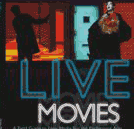
field guide to new media for the performing arts
The Multimedia Performance Studio at Geoarge Mason University creates original productions, often drawing on historical or science fiction sources; innovative stagings of opera and new music theater; multimedia scenography for theater, dance and performance art; and indoor and outdoor projection installations.
They have created a guide that is freely available which includes essays on history and theory, a portfolio of work, production practice, technology and resources related to their practice of new media performance.
Kirby Malone and Gail Scott White, editors of the guide, are also collaborators on Cyburbia Productions.
Posted by michelle at 03:03 PM | Comments (0)
Charade
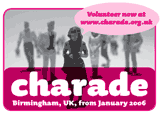
human RAM
In Charade, artist Simon Pope outlines a scenario where data, stored in peer-to-peer networked computer systems - under threat from hacks, crashes, viruses and legal constraint - takes flight back into the human body. Participants, engaged through a local publicity campaign, workshops and a large-scale live event, become part of a distributed performance of walking and memorizing.
Volunteers attempt to memorize a chosen piece of music, film, tv programme, play or book; through a process of walking, memorizing, remembering and reciting, they each attempt to 'become' their favourite 'media asset'; support is given to them through a series of theatre workshops and website; a number of volunteers record their progress as 'video diaries', made available online; at a large-scale public event all volunteers congregate to recite their chosen piece while wandering together, en masse – a re-creation of the final scenes of Truffaut's Fahrenheit 451.
Posted by michelle at 02:05 PM | Comments (0)
April 04, 2006
eRuv: A Street History in Semacode
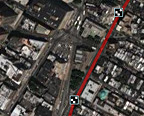
Inscribing a Story on a City with 2D Barcodes
eRuv is a digital graffiti project installed along the route of the former Third Avenue elevated train line in lower Manhattan. The train line, dismantled in 1955, was more than just a means of transport; it was part of an important religious boundary — an eruv — for a Hasidic community on the old Lower East Side. Using semacodes, the former boundary is reconstructed and mapped back onto the space of the city. Pedestrians with camera phones can then access location-specific historical content linked through the semacodes.
What is an eruv? An eruv (pronounced ey-roov) is a structure erected around orthodox Jewish communites throughout the world. It usually consists of a series of poles connected by a cord that circumscribe an urban neighborhood, often incorporating existing municipal infrastructure such as utility poles and electrical wires. They are erected with the permission of local authorities and in accordance with the lengthy and complex set of architectural laws set forth in the Talmud. The construction of eruvin (or eruvim, plural for eruv) stems from the observation of Shabbat, the weekly sacred day of rest (Friday sundown to Saturday sundown) that includes a prohibition against carrying objects outside of one's home, or private domain. The reason Jews construct eruvin is that according to most Rabbinic authorities, the shared public space within an eruv is considered the private domain of a community. In this way, observant Jews can carry their keys or prayer books on the Sabbath while acting in accordance with sacred principles.
Is Manhattan an eruv? Natural topographic boundaries such as rivers, cliffs and ravines can also form one or more legitimate sides of an eruv. For this reason, it is possible from a number of Talmudic perspectives to consider the entire island of Manhattan an eruv. This has been debated over the centuries-long course of Jewish habitation in the city — rabbis differ over the extent to which the island would require physical intervention for it to qualify as an eruv.
The old East Side eruv: In 1907, Rabbi Yehoshua Siegel, a renowned Talmudic authority who had immigrated to the Lower East Side from Poland, published Eruv V'Hotza'ah, in which he wrote:
With regard to the city of New York, where we are presently living, the issue has come before the trembling ones that it is possible to permit carrying on Shabbat throughout the East Side. The argument is that the water which surrounds it on three sides should be considered a complete wall because of its depth. The fourth wall is a door frame like none other: the elevated iron pathway which stretches the length of the city, from one end to the other, from the water of the southern tip, South Ferry, to the water at the northern tip, without any interruption to Harlem.
The eruv was soon refuted by other prominent rabbis and rejected en masse by Lithuanian Jews who also lived on the Lower East Side at the time.
What is semacode? A semacode is like a bar code that you see on your groceries. Except that instead of holding product information it represents a URL, or web address. You can print semacodes on a piece of paper or on an adhesive sticker and put them places. This way you can put web addresses on walls or streets, or on anything. In order to use them, you need a semacode reader, or a compatible camera phone that is connected to the Internet.
Visit eRuv for more information
Posted by jesse at 07:18 PM | Comments (0)
FILE Symposium

Sonic, Ludic, Digital
FILE Electronic Language International Festival in Sao Paulo, Brazil, August 14 to September 3, 2006. Call for Proposals open from Febraury 10 to April 10, 2006.
FILE is a non-profit cultural organization whose purpose is to disseminate and to develop arts, technologies and scientific research, by means of exhibitions, debates, lectures, and courses. The festival promotes an yearly meeting in Brazil, in the city of São Paulo, of international arts and new-media professionals.
FILE's seventh edition happens at SESI's Art Gallery, with the exhibition of webart, netart, artificial life, hypertext, computer animation, real-time teleconference, virtual reality, software art works, besides games, interactive films, e-videos, digital panoramas, and electronic-art and robotic installations, in interactive and immersive rooms.
Posted by michelle at 03:14 PM | Comments (0)
TOPLAP

(Temporary|Transnational|Terrestrial|Transdimensional) Organisation for the (Promotion|Proliferation|Permanence|Purity) of Live (Algorithm|Audio|Art|Artistic) Programming
TOPLAP is a livecoding audio-visual performance group. Check their wiki for FAQs to find out such illuminating questions as: What's the difference between generative music and live coding?
DEFN 1 Generative music is created from some algorithm, usually running autonomously. There may be controls (parameters/arguments) to this process but the algorithm itself is fixed. Live coding is a way to substantially modify the actual nature of that algorithm, even as it calculates, in a realtime performance or interactive composition setting.
DEFN 2 They are kind of opposites. Generative music is about sowing seeds, comparable with genetic modification; altering DNA, putting the DNA in eggs, and watching it grow to see/hear the effects. In contrast, live coding is more about piecing animals together from scratch in the womb, splicing different live animals together, modifying their DNA while they're still growing, then experimenting with different ways of slaughtering them to get the best audio/visual/aromatic effects.
Note the above contains bold use of metaphor, TOPLAP do not condone any such activities on real life-forms (computer processes are not known to experience pain, and don't have faces).
Posted by michelle at 12:44 PM | Comments (0)
April 01, 2006
Where's Jo
Hi Everyone,
Just in case you're wondering what's happened to me, I'm in South Africa and will be returning on April 15.
Best,
Jo
Posted by jo at 06:26 AM | Comments (0)
